August 27 - September 2, 2023: Issue 596
Ringtail Posse 7: August 2023
Geoff Searl OAM: Tawny Frogmouth, Peter Macinnis: echidna, Peter Carter: Ringtail Possum, Nathan Wellings; Kookaburra
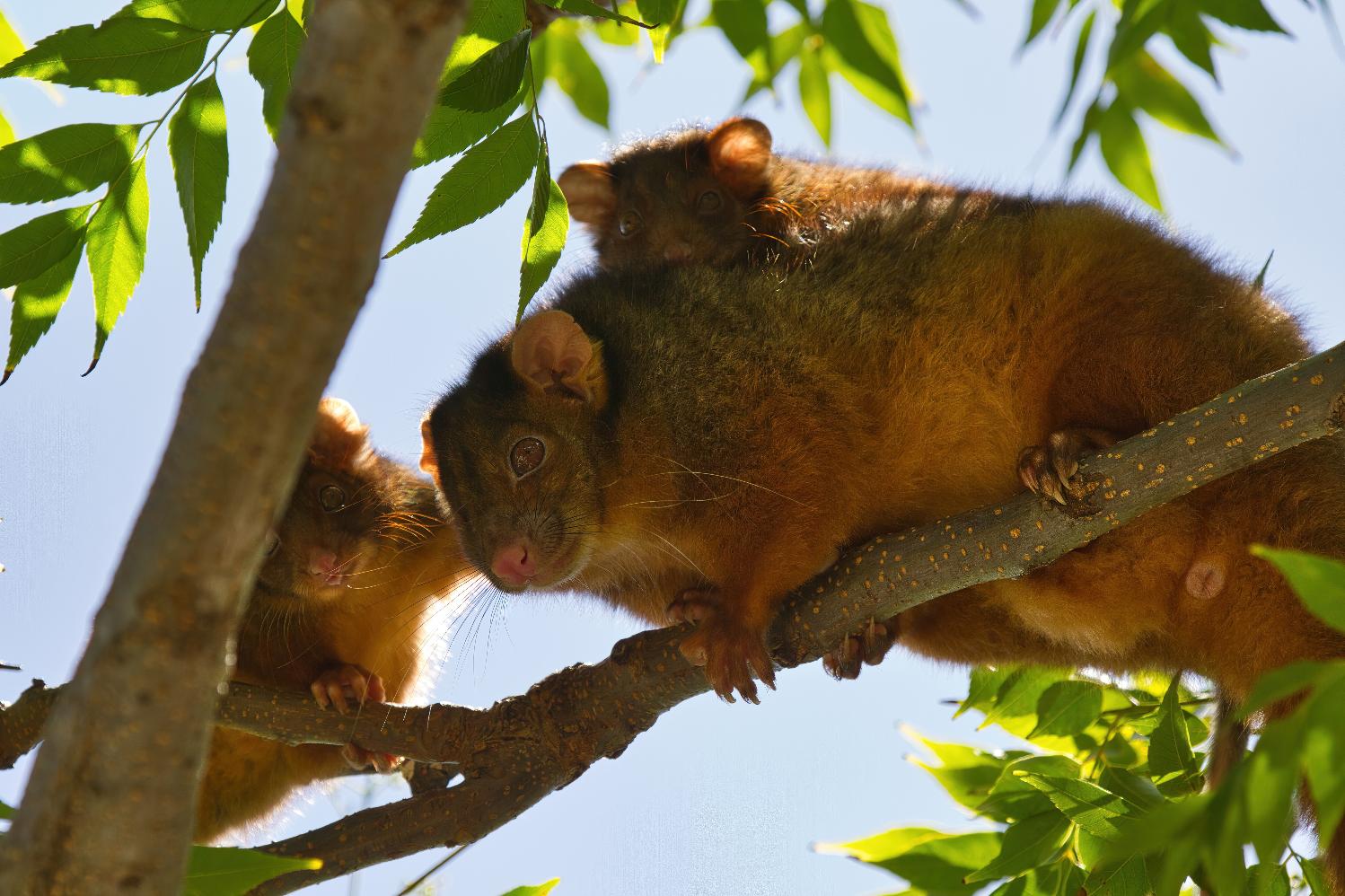
Readers have pointed out that the Ringtail Posse Rounds run so far have been ladies heavy – so this Round, a blokes only focus – because blokes love our wildlife too and it’s more than ok for them to say so.
The gentlemen who run in the August 2023 have all grown up in our area, some even have connections to this place that go back over several generations and 100 years.
Definition from:
Ringtail: from the 'Common Ringtail Possum' which is not so common anymore in urban areas. The Common Ringtail Possum is found along the entire eastern part of Australia and south west Western Australia. They are also found throughout Tasmania. The western ringtail possum is a threatened species under State and Commonwealth legislation. In Western Australia the species is listed as Critically Endangered fauna under the Biodiversity Conservation Act 2016.
+
Posse: noun. 1 : a large group often with a common interest 2 : a body of persons summoned by a sheriff to assist in preserving the public peace usually in an emergency 3 : a group of people temporarily organised to make a search (as for a lost child) 4 : one's attendants or associates.
On Wednesday June 21st 2023 a Motion regarding Heritage Protection was passed in the NSW Parliament. Tabled by The Hon. Peter Primrose, contributors to the discussion spoke of the Minns Government's commitment to developing the State's first heritage strategy, in which the Government will develop options to recognise and protect significant trees, urban bushland and wildlife corridors.
This was, of course, music to the ears of all who are working at ground level in these areas to safeguard the survival of the urban wallaby, koala, lizard, skink, snake, bandicoot, every bird of woodland, water and grassland, insects and every other wildlife species we share suburbia with.
In recent approved DA’s Council is listing as a requirement of consent in Assessment reports to look after the other residents of this area, the wildlife. On blocks where people wish to remove large amounts of trees that are clearly homes for local fauna a wildlife expert must assess these prior to any removal taking place, nesting boxes are required to be installed afterward and Ecologists must be on site during their removal.
Recent examples and instances are:
Bandicoot/Penguin (Avalon)
Long-nosed Bandicoots & Little Penguins – Best Practices for Residents
Residents are encouraged to follow a number of Best Practices to assist with the protection and management of the endangered populations of Long-nosed Bandicoots and Little Penguins:
Long-nosed Bandicoots, Little Penguins and other native animals should never be fed as it may cause them nutritional problems, hardship if supplementary feeding is stopped, and it may increase predation.
Feral cats or foxes should never be fed or food left out where they can access it, such as rubbish bins without lids or pet food bowls, as these animals present a significant threat to Long-nosed Bandicoots, Little Penguins and other wildlife.
The use of insecticides, fertilisers, poisons and/or baits should be avoided on the property.
Garden insects will be kept in low numbers if Long-nosed Bandicoots are present.
When the North Head Long-nosed Bandicoot Recovery Plan is released it should be implemented where relevant.
Dead Long-nosed Bandicoots or Little Penguins should be reported by phoning Manly Council on 9976 1500 or Department of Environment and Conservation on 9960 6266.
Please drive carefully as vehicle related injuries and deaths of Long-nosed Bandicoots and Little Penguins have occurred in the area. Care should also be taken at night in the drive way when moving cars as bandicoots will seek shelter beneath vehicles.
Cat/s and or dog/s that currently live on the property should be kept indoors at night to avoid disturbance/death of native animals. Ideally, when the current cat/s and/or dog/s that live on the property no longer reside on the property it is recommended that they not be replaced by new dogs or cats.
Report all sightings of feral rabbits, feral or stray cats and/or foxes to N B Council.
And;
Protection of Habitat Features
All natural landscape features, including any rock outcrops, native vegetation and/or watercourses, are to remain undisturbed during the construction works, except where affected by necessary works detailed on approved plans.
Reason: To protect wildlife habitat.
The Reason given in all instances is: To protect native wildlife.
This follows on from the 2022 Local Government NSW Conference where a Motion was passed - That Local Government NSW lobby the NSW Government to:
- In conjunction with industry associations, introduce enforceable standards for the preparation of flora and fauna management plans.
- Consider Codes of Practice and Guidelines for handling native wildlife and other best practice and animal welfare laws in development of the standards.
- Consult with Councils, National Parks and Wildlife Service, Ecological Consultants Association of NSW, wildlife rescue organisations and other relevant agencies in the preparation of standards.
Such a standard should include requirements for:
- Pre-clearance surveys to be carried out to establish which species are present on the site, including identification of any threatened and native species.
- The identification of suitable nearby areas where wildlife could possibly be relocated.
- The provision of possum, glider and bat boxes sufficiently in advance of vegetation clearing to allow wildlife time to discover the boxes and become familiar with them.
- Compliance with the NSW Code of Practice for Injured, Sick and Orphaned Protected Fauna and the licencing requirements contained in the Biodiversity Conservation Act 2016.
- Best practice for wildlife handling and care (including contact with local wildlife rescue groups).
- Reporting of injured or killed fauna to the NSW Department of Planning, Industry and Environment to enable the data to be used in statewide biodiversity monitoring programs.
The premise of this is that mandatory pre-clearance surveys to establish what wildlife lives there before works commence, and to document this in a formal way, should be required on any site that has vegetation and for which a DA has been approved. The experience is that often vegetation is removed before an application is submitted, often leaving wildlife with no home. Wildlife then ends up on roads dead or dies after being displaced/evicted.
One wildlife carer cited a recent Pittwater case of a powerful owl pair site that had had vegetation removed to make the development more likely to proceed – the nest and two babies were destroyed.
‘It’s hard to prove wildlife is/was present after the clearing as they aren’t there.’
‘Once trees and vegetation are removed the problem is where do these animals go?’
Powerful Owls are also not so common anymore in urban areas.
However it's clear human residents of this LGA have a deep and abiding love for and connection to these other furry, scaled, finned and feathered locals. We listen for them during the night, happy when we hear their footsteps scampering across our rooves and fences or their soft hoots across the valleys.
We look out for them during the day, delighted with their presence.
Residents here are distressed when they find injured wildlife or witness wildlife being attacked. They are not in denial that all our local wildlife feels and thinks - they cry when their babies are killed in front of them, mourn the loss of a mate - people who have heard or seen this never forget.
Data kept by the NSW Environment Department, although only listing incidents from June 2013 to June 30 2021, shows that 33,391 wildlife animals have been rescued in our area between June 2013 and June 30 2021 and just 8, 812 released again. Of these 42 were threatened species.
Data to 30 June 2021 lists of the 5, 235 animals rescued during that 2020 to 2021 period just 1,573 were released. Across NSW during that same year a total 120, 927 animals were rescued and just 28, 805 released - 5, 122 of these were were threatened species (104 kinds) of which just 1,180 were released.
These figures and data do not take into account all the wildlife found deceased beside or on roads or elsewhere.
Overall the data states 723, 438 animals have been rescued across New South Wales and 181, 468 released.
''This study draws on 469,553 rescues reported over six years by wildlife rehabilitators for 688 species of bird, reptile, and mammal from New South Wales, Australia.... Of the 364,461 rescues for which the fate of an animal was known, 92% fell within two categories: ‘dead’, ‘died or euthanised’ (54.8% of rescues with known fate) and animals that recovered and were subsequently released (37.1% of rescues with known fate).''In total, there were 872,087 records reported during the six-year (2013–14 to 2018–19) study period. Just over 97% of these came from three animal groups–birds, mammals, and reptiles. Of the total number of records, 402,534, (46%) were excluded from the descriptive analysis because they: a) did not contain any information about the animal, or the animal’s identification was ambiguous and could not be placed within a group (e.g. an ‘unidentified animal’); b) contained only sightings of animals and were not attended to in some way by a wildlife rehabilitator; c) were records of amphibians (373 records) or non-vertebrate fauna (e.g. spiders, insects, etc.); d) were non-avian marine vertebrates such as whales, seals, sharks, rays, fish etc; e) were reported as floating, drowned, or washed up animals (deemed an ambiguous cause for rescue, n = 48); f) contained both an ‘unknown’ cause for rescue and an ‘unknown’ fate; or f) were an introduced or spurious species (e.g. extinct, or out of known range). These exclusions resulted in a dataset for descriptive analysis of 469,553 records i.e. 54% of the initially reported amount.''
Many people state we are the generation witnessing the extinction of urban wildlife. There has been generation after generation of humans living alongside and with wildlife, until this one.
It's not just the Pittwater koalas that have gone, other species, like the ringtail possum or long-nosed bandicoot are disappearing, along with their joyful snuffles and squeaks, from our urban backyards and the trees that tower over them.
There is a growing silence at night for those species that forage for food then - possums, wallabies, owls. The same is occurring for those that are active during daylight.
Although many point to the impacts of cat and dog attacks due to irresponsible owners, there is also what is termed the 'inconvenient possum' in a roof or garden shed, because its home tree has been cut down. These are caught by those hired, some of whom have little knowledge or scruples, and release them into areas out of their home range - a death sentence for that possum as this species is territorial, along with requiring certain food trees in order to eat, to survive.
There is predation by other introduced species - readers regularly send in photos and videos of foxes roaming and killing at night.
There are roadkill black spots, places where wallabies or turtles or possums used to cross the area where a road has been cut through and a speed limit that means death for wildlife. There are no 'speed humps' in place, and no plan at a local, state or federal government level to install these. Residents and wildlife rescuers have reported some drivers 'aiming straight for' a stricken animal.
There is the razing of blocks of land for development prior to any required assessment of the environment taking place to circumvent those requirements so a report can state 'nothing present'. There is nothing present because its habitat has been cleared or the wildlife killed by these actions.
Our local wildlife carers are exhausted, state there have been so many, too many so far this year - they are increasingly heartbroken with all the babies they lose, they cry every day, and then pick themselves up and get on with trying to save the next critter, and the next.
Wildlife carers are all volunteers - they do the rescues, sometimes horrific rescues, run to and fro from the great local vets who help out trying to save them, they gather or pay for the food, for the milk, for the petrol, for the electricity to keep bubs warm. There are no grants or funding for Australia's wildlife carers - they have to raise funds through running events, raising awareness, collecting cans for a 10 cent return.
This year a celebration of residents' favourite wildlife runs as Profiles across 2023 - simply to allow those who love a chosen 'critter' to speak for them a little, to remind us of what is here and what we feel connected to has feelings too.
Information about these species and how many or why we are losing them is included - just so we can think about how we, as individuals and as one community, can turn around that growing silent emptiness closing in around us and these other ones we love.
Ultimately the founders of the Ringtail Posse are hoping everyone chooses to become a Member of the Ringtail Posse and keep their other loved one safer in its one and only home.
Reason?: To Protect Local Wildlife so it becomes 'common' and safer for our wildlife to be everywhere once more.
Further studies and reports that have come out since the last Ringtail Posse Round, along with relative information, runs below these four gentleman's favourite local wildlife species.
To join in please email us with 'Ringtail Posse' in the subject line - with so many local species of wildlife, vital insects and seals flopping around on the sand or penguins flitting through the seas and estuary, there are several on the lists that haven't been claimed for guardianship yet - what's yours?
Round 7 of Ringtail Posse Profiles includes the following now officially joined Members:
Geoff Searl OAM
Avalon Beach legend, grew up in the area. President of the Avalon Beach Historical Society, Life Member of Avalon Beach SLSC, Volunteer Bushcarer, J.P.,
What is your favourite local wildlife species?
Without question the Tawny Froggies (Tawny Frogmouth).
Why do you like the Tawny Frogmouths?
They’re so gorgeous, the parents are so loving of each other – I really get off on that; the two of them sitting side by side, just looking like a really happily married couple, I think they’re gorgeous. Plus their babies are so cute, you’d just love to cuddle them too – they’re gorgeous. I love everything about the Tawnies; the sound they make, the families they clearly are, I love everything about them.
How long have seen or heard the Tawny Frogmouths?
We have a 70 year old melaleuca at the front of the house and there was a couple that used to live up in there. For some reason they disappeared – it might have been when we got a dog, we’re not sure what the story was. But they then appeared at a friends place just one street down from us but then she moved and we haven’t seen them for ages – very sad for us. We haven’t seen any Tawny Frogmouths apart from a bushwalk through McKay Reserve or somewhere like that.
Have you noticed any changes in the number of tawny Frogmouths your local neighbourhood?
Well for us, because we had such a lovely intimate connection, the contact with them has diminished, solely due to no longer have that connection with the two that were living in our mighty melaleuca. I haven’t seen any around anywhere else either – not even in Angophora Reserve, where we spend 3 hours a month in there with the bushcare group.
Have you heard any at night?
Yes, sometimes we hear a little bit of them at night – but always far off, across the valley, but still not much then. You can hear them when it’s super quiet, but always at a distance.
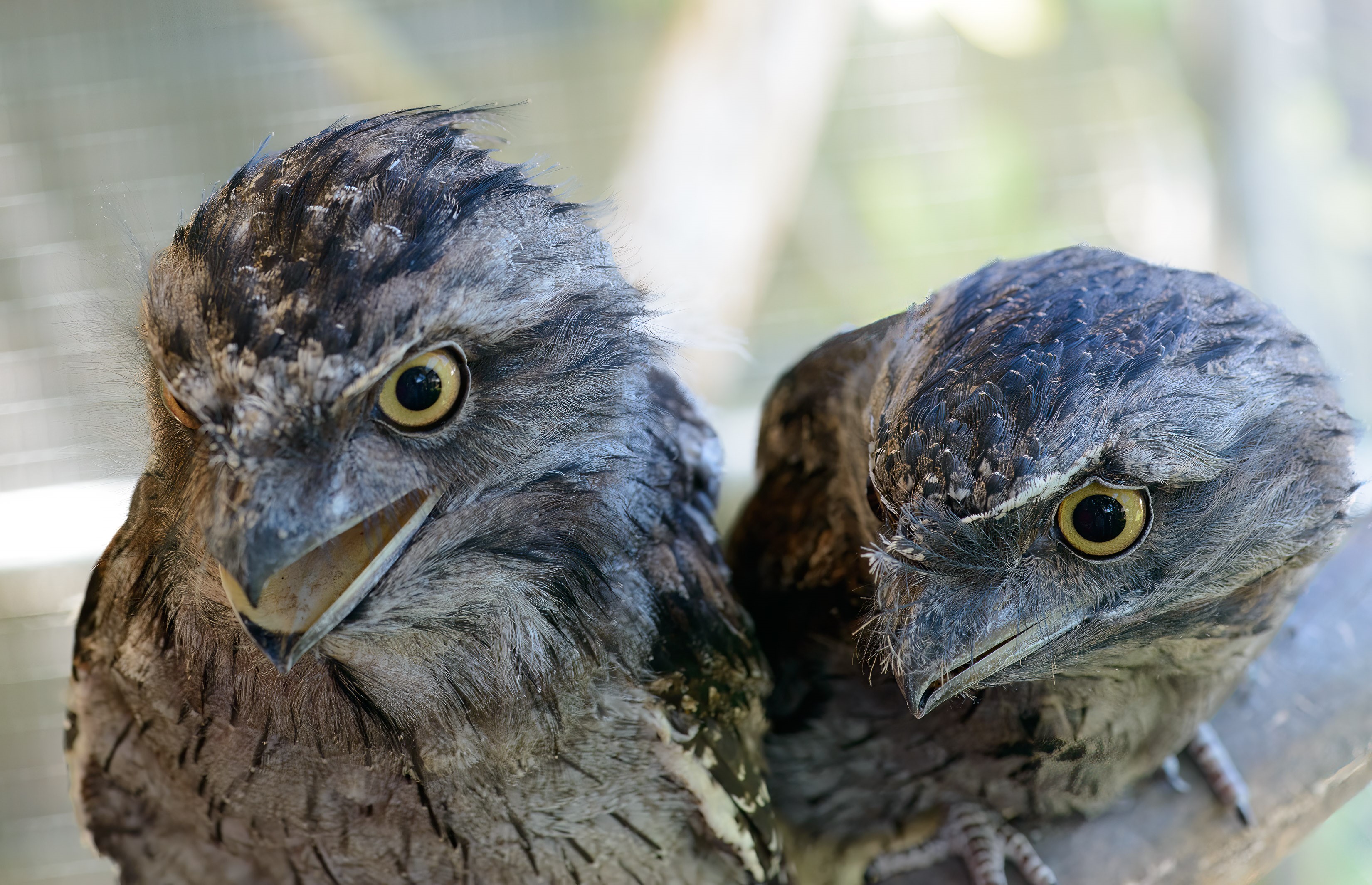
Tawny Frogmouths in care at Bilgola Plateau last year. Photo: Michael Mannington, OAM
Geoff Searl OAM, President of the Avalon Beach Historical Society. Photo: A J Guesdon.
Unfortunately we are losing a lot of our local Tawny Frogmouths to rat poisons, along with other species of owls and raptors. In the past week one resident found a dead Tawny Frogmouth on his driveway at Careel Bay, it had not bene struck by a car, it had died from consuming poison. At south Avalon a brown goshawk found by a resident was taken to Taronga Zoo but unfortunately could not be saved as it had consumed something that had consumed a rat poison.
At the October 2022 Council Meeting Cr. Glanville put up a motion for council to phase out the use of all anticoagulant rat poisons by April this year, along with reporting by May on the use of herbicides, fungicides, pesticides, insecticides, rodenticides and chemical management of vertebrate animals. Ms Glanville accepted an amendment for staff to brief councillors within four weeks on the environmental and financial costs and benefits of using SGARS or alternatives and the feasibility of phasing out their use amongst Council contractors. At the November 2022 Council Meeting it was Resolved that Council:
1. Council phase out use of Second-generation Anticoagulant Rodenticides (SGARs) on land owned or managed by Council.
2. The Chief Executive Officer report back to Council by August 2023:
A. progress of the phase out of SGARs by Council and relevant third parties (eg suppliers, contractors, tenants)
B. considerations as to usage of other chemicals on Council lands that may pose environment or human health risks
C. available alternative methods and implications for Council.
3. Council seek opportunities to further educate the community regarding SGARs and other harmful chemicals and recommendations for safe alternatives.
No Report and nothing else on this subject was listed for the August 2023 Council Agenda. Concerned residents can contact Cr. Glanville and their other representatives on what progress council has made and when the Report on progress to phase these deadly chemicals has been made.
Addresses were given on this subject by Birdlife Australia’s Urban Bird program coordinator, Dr Annie Naimo, and wildlife carer and retired toxicologist Edwina Laginestra at that October 2022 Meeting. These run as follows:
My name is Edwina Laginestra, I’m a local wildlife carer, and retired-scientist specialising in toxicology
Rodenticides – both first generation and second generation anti coagulants – are used to kill “pest rodents” but increasingly it is harming our wildlife. Especially in winter, many unwanted creatures come into our homes and other buildings for warmth and food. People see ratbait as an easy and out-of-mind solution but don’t generally think about other impacts. Our wildlife is affected both directly (as I have treated both brushtail possums and blue tongue lizards for ratbait) and indirectly (as predators such as raptors eat the baited rodents which are sick and an easy catch and have residual poison concentrations). Many pets are also affected. SGARs have been banned in other countries due to longevity in the environment.
Treating baited wildlife is horrific and most do NOT survive. Rodents take around 3 to 9 days to die, but animals with slower metabolisms, such as our marsupials, take longer. Regarding SGARs it takes 14 days for symptoms to show in a possum and 21 days for it to die (from NZ research). If we can get it early we have a chance and have to treat the possum for 6-8 weeks (volunteer carers pay for treatment, and vets may charge us at cost only). However, sometimes we do not know what we are dealing with and by the time the symptoms show it is too late. I have treated well over a dozen brushtail possums. I think only 3 survived – 2 were young and OK with treatment in captivity. One was an adult male who was in care for 3 months – ratbait treatment then physio and containment for regaining muscle strength. The Koagulon he was treated with cost $150. Often we get in a beautiful mum that has been baited and have to try and save the joey that may already be bleeding internally.
Earlier this year I picked up a beautiful barn owl that was sitting in the middle of Seaforth Oval – a dog had attacked it even though the owner was quick to realise what was happening. But the owl was now badly injured. Why could the dog attack it and break a wing and pelvis? Because it was already unwell with eating baited rodents. What an horrific end of life. We have been picking up boobooks and Tawny Frogmouths that were likely baited but it is only recently there has been funding to test for harmful chemicals.
I have also picked up many ringtail possums that have eaten tips of freshly sprayed hedges. They foam at the mouth and spin as they die (which can take more than 8 hours). I spoke to Yates about systemic treatments in some plants for psyllids. They felt the poison may be active within the plant (and leaves) for up to 6 months. So although ringtail possums rarely take SGARs, they are very vulnerable to herbicides. However yesterday I had a ringtail die suddenly – he’d been in care for 5 days, but suddenly he was very thirsty and dizzy. I administered fluids and antibiotics (as he’d had surgery) but he died with blood coming out of his nose, paws and abdomen. He was probably already dying for a week before coming into care. He may have eaten bait due to habitat and food loss.
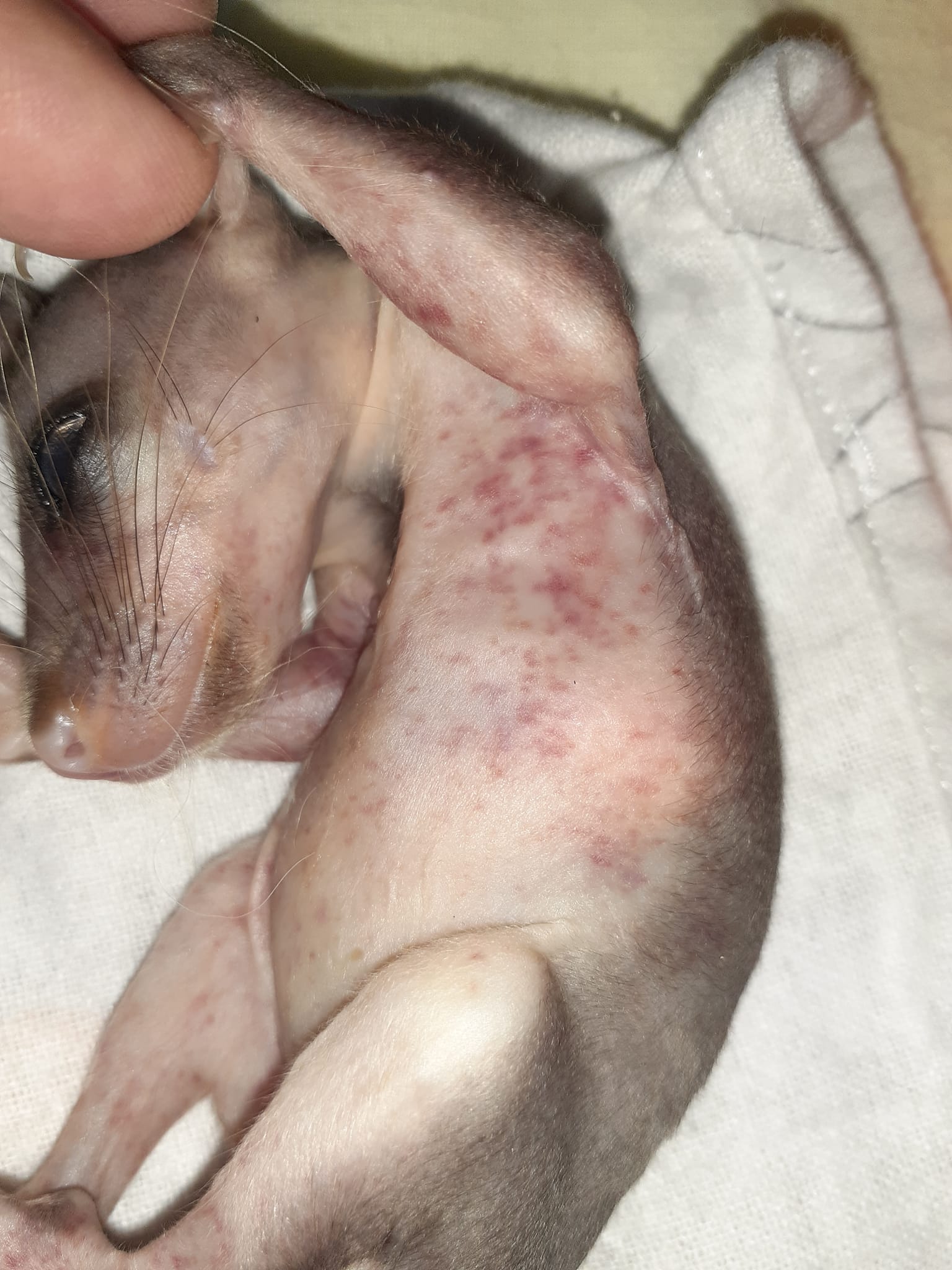
Photo: brushtail joey un-emerged rodenticide, image supplied
Wildlife carers are the volunteers that spend the most money on their volunteering. We also already have quite a number of patients already in care. Giving drugs and physio adds extra time to our care load. We also spend time taking them to the vet who are also pressed for time and often treat wildlife for free. Sometimes we simply do not know what we are dealing with and administer treatment too late or incorrectly and we can make symptoms worse. This causes great anxiety as well. If there are actions others can take to avoid wildlife coming into care that would be most helpful – regarding pest management there are many other options in the cities – including the natural pest management our wildlife provides. Watching an animal get worse and die in care is tough emotionally and physically.
Barn Owl that died from Ratbait secondary poisoning. Image supplied
Dr Annie Naimo, Urban Bird Program Coordinator, BirdLife Australia
I’m writing on behalf of BirdLife Australia to support your motion to phase out the use of Second-generation Anticoagulant Rodenticides (SGARs).
BirdLife Australia is an independent non-partisan science-based bird conservation charity with over 300,000 supporters. Our primary objective is to conserve and protect Australia’s native birds and their habitat. We are the national partner of BirdLife International, the world’s largest conservation partnership.
Second-generation anticoagulants pose an extreme threat to native birds and wildlife. SGARs take several days to kill pests, and in this time accumulate in the body of poisoned animals.
SGARs persist in the body for a long duration, and in carcasses after death- posing additional risk to wildlife that may prey upon poisoned animals.
In greater Sydney, research undertaken by BirdLife Australia has found fatal levels of SGARs in dead Powerful Owls, a vulnerable species. Further Australian studies have shown similar fatal levels of SGARs in other birds of prey, such as Southern Boobooks and Wedge-tailed Eagles.
Other Australian wildlife are also at risk and have had documented instances of SGAR poisoning, including marsupials, native rodents, and reptiles, as well as pet cats and dogs.
Because of the clear evidence and risks, SGARs have been heavily regulated in Europe, Canada, and the USA. Many other local governments areas in NSW are already phasing out SGARs in their community, including Randwick, Wollongong, Tweed Shire, Port Macquarie-Hastings and Kiama.
Importantly, there are alternative pest control products available (e.g. first-generation anticoagulant rodenticides, non-anticoagulant rodenticides including cholecalciferol) that are similarly as effective as SGARs, but pose significantly less environmental risk when administered correctly.
To support you in your transition away from SGARs, BirdLife Australia has developed an Action Kit for Councils. The Action Kit details how SGARs threaten wildlife and pets, provides effective ways that councils can move to alternative pest control methods, and includes links to additional resources to help you to keep your local community safe.
There is also a BirdLife Australia Open Letter you can add your name to. This calls for government Ministers to help get dangerous Second-generation Anticoagulant Rodenticides regulated properly in Australia. More at: www.actforbirds.org/ratpoison
In our LGA 103 Tawny Frogmouths have been rescued and 29 released in the June 2020 to June 2021 data period alone - 861 have been rescued and just 222 released over the whole of the June 2013 to June 2021 data period recorded - which may not be as accurate as hoped - as explained above, and also list a further 461 'unidentified' birds that have been rescued and a further 16 'dependent young' without a species classification allocated.
Collisions with motor vehicles and ‘unsuitable environment’ are listed as the primary reasons for the birds coming into care. Disease, listed as an ‘internal parasite’ is also listed. Obviously deaths from poisons needs to be added to causes of mortalities.
Tawny frogmouths will often perch at the sides of roads where streetlights attract moths. Another reason to slow down on our local roads.
The tawny frogmouth (Podargus strigoides) is a species of frogmouth native to the Australian mainland and Tasmania and found throughout. It is a big-headed, stocky bird, often mistaken for an owl, due to its nocturnal habits and similar colouring, and sometimes, at least archaically, referred to as mopoke, a name also used for the Australian boobook, the call of which is often confused with that of the tawny frogmouth.
Tawny frogmouths are carnivorous and are considered to be among Australia's most effective pest-control birds, as their diet consists largely of species regarded as vermin or pests in houses, farms, and gardens. The bulk of their diet is composed of large nocturnal insects, such as moths, as well as spiders, worms, slugs, and snails but also includes a variety of bugs, beetles, wasps, ants, centipedes, millipedes, and scorpions. Large numbers of invertebrates are consumed to make up sufficient biomass, as are reptiles and frogs, and birds.
The conservation status of tawny frogmouths is "least concern" due to their widespread distribution. However, a number of ongoing threats to the health of the population are known. Many bird and mammalian carnivores are known to prey upon the tawny frogmouth. Native birds, including ravens, butcherbirds, and currawongs, may attempt to steal the protein-rich eggs to feed their own young. Birds of prey such as hobbies and falcons, as well as rodents and tree-climbing snakes, also cause major damage to the clutches by taking eggs and nestlings. In subtropical areas where food is available throughout the year, tawny frogmouths sometimes start brooding earlier in winter to avoid the awakening of snakes after brumation. Since 1998, a cluster of cases of neurological disease has occurred in tawny frogmouths in the Sydney area, caused by the parasite Angiostrongylus cantonensis, a rat lungworm.
__________________________________________________________________________________________
Peter Macinnis
Peter is a science writer, and has also been a teacher and museum educator. The author of twenty books for adults and children, Peter has just completed The Nature of North Head. The work covers the history, geology and biology of North Head, one of the sentinels guarding Sydney Harbour. As a volunteer in the plant nursery there, and as a trained biologist, I have detailed knowledge of the lower and higher plants, the invertebrates and the vertebrates, as well as the geology of the area. This is a guide and companion for walkers and wanderers. Available on Kindle, and also as a free low resolution PDF.
Peter says, ‘’ I work on North Head as a volunteer, weeding, planting and doing other stuff to help maintain a fragile system, but I am also a lifelong educator, and wearing that hat, I decided to generate a web site about the place, and host it myself. It was to show the casual visitor just how much more was there to be seen.’’
What is your favourite local wildlife species?
The echidna, Tachyglossus aculeatus aculeatus.
Why do you like the echidna?
I like the species because a few are trusting enough to walk over my feet, and the rest don't run away. Also, they have the most amazing genomes that you could imagine, and like naked mole rats and humans, they live for much longer than you would predict from their body mass: the record appears to be fifty years. Like the wombat in Ivan Smith's Death of a Wombat, their locomotion is waddle-and-crump. I see them while walking the tracks, though sometimes when I am working, one will come over to supervise me.
As a rule, I only handle wildlife when it is absolutely essential, but some years back, we found one trapped in a locked drain on North Head and we knew the drain was due to flood, which would have drowned it. The rangers unlocked the drain, but then left me to try to persuade the animal to let go of a ladder that went down into the drain. I was kneeling on steel mesh, and likely to pitch head-first into a metre of water. The rangers cheerily told me they would haul me out by the ankles...
Echidnas are amazingly strong and stubborn, and also spiny, but knowing the beasts' habits fairly well, I pulled a trick (only other wranglers need to know the details) that persuaded it to let go. I set it gently down on sandy soil, where it dug in, ignoring me completely. I like that sort of independence.
Also, echidnas' back feet point backwards, and they are found from the highest mountains down to the sea, from Cape York to Tasmania to Cape Leeuwin in WA and across the Top End. Even bush flies cover less of the continent.
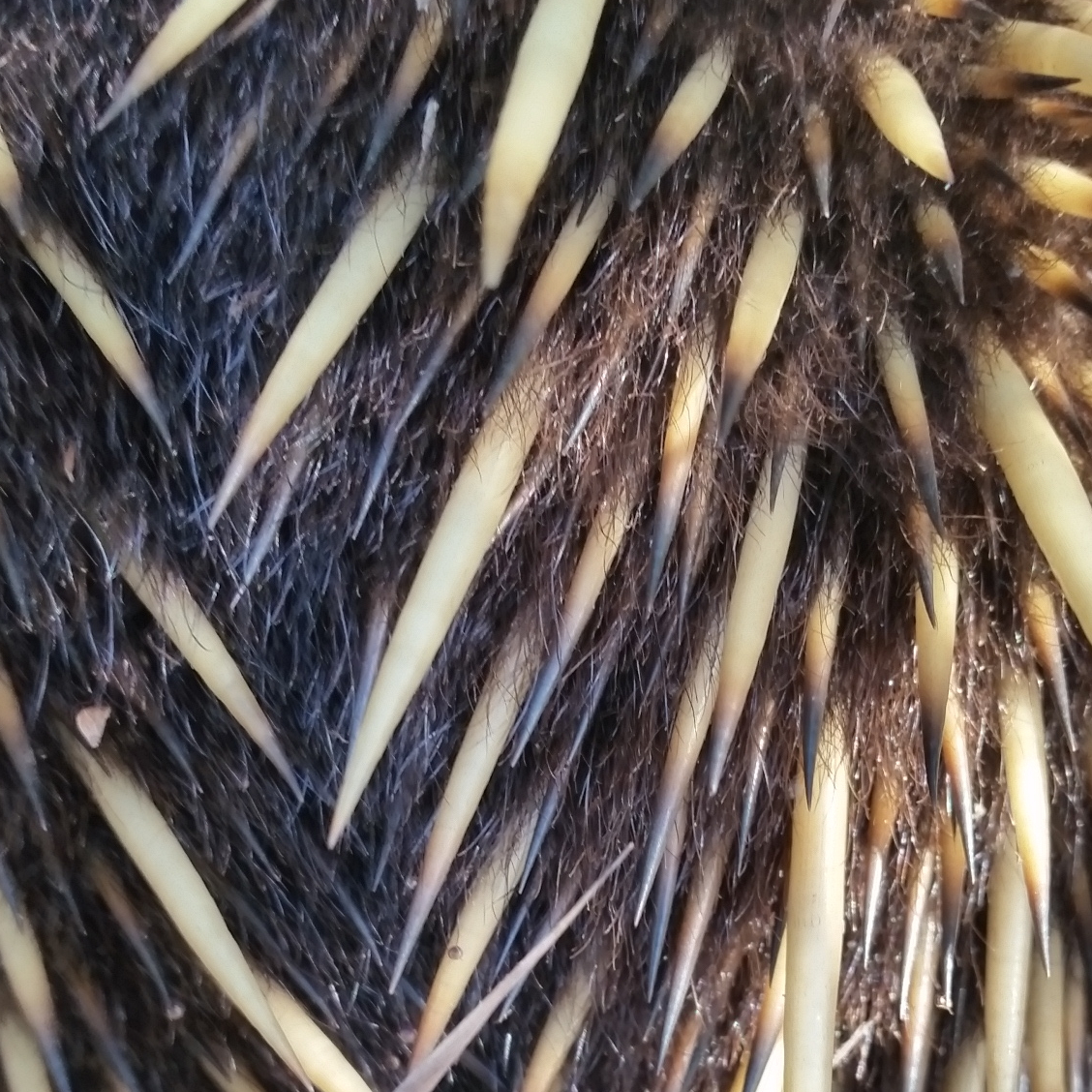
Echidna 'hair'. Photo: Peter Macinnis
How long have seen or heard the echidna?
I met my first one in the Budawang Ranges in 1970, and twelve years back, having joined the volunteers at North Head, I started seeing them there. My best score was three in one day, two of those being while I took 40 Architecture students around while we discussed land care methods and management. The second mugged to all their cameras, even licking the lenses. How can you hate such total media tarts?
Have you noticed any changes in the number of echidnas in your local neighbourhood?
We believe that we have 19 echidnas up there (North Head), of whom I have seen perhaps a dozen, and I think two of those recognise me. There is no predicting where or when they will show up, but we echidna obsessives report them to a citizen science group, Echidna CSI, and we believe that the echidnas will still be there, after humans wipe themselves off the face of the planet.
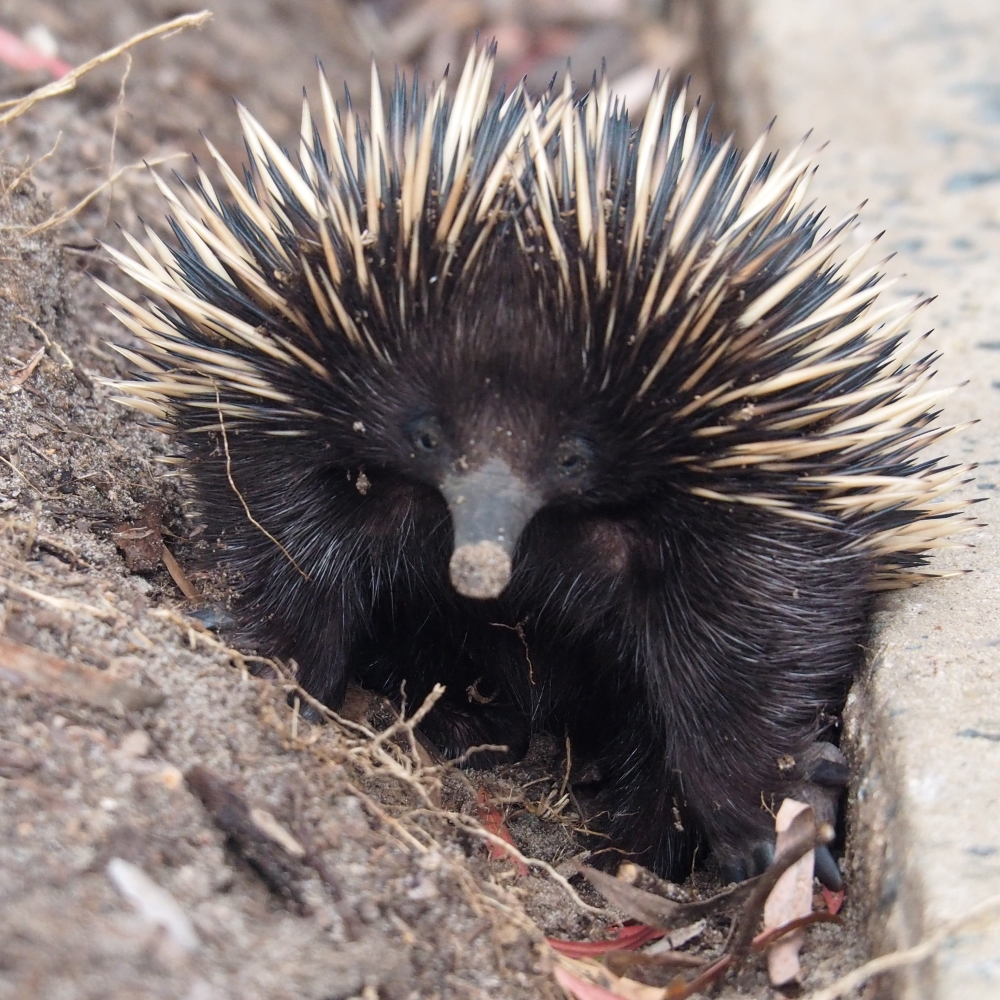
North Head Echidna. Photo: Peter Macinnis
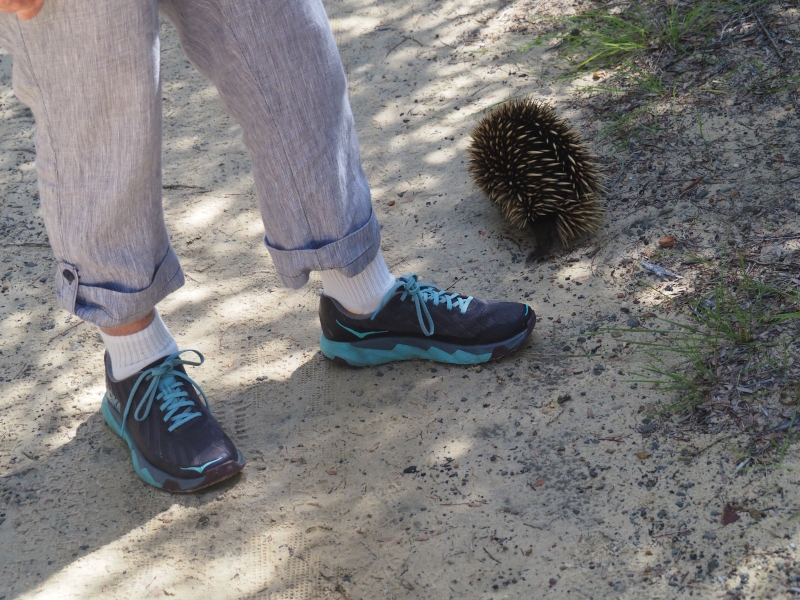
North Head Echidna on the fire trail. Photo: Peter Macinnis
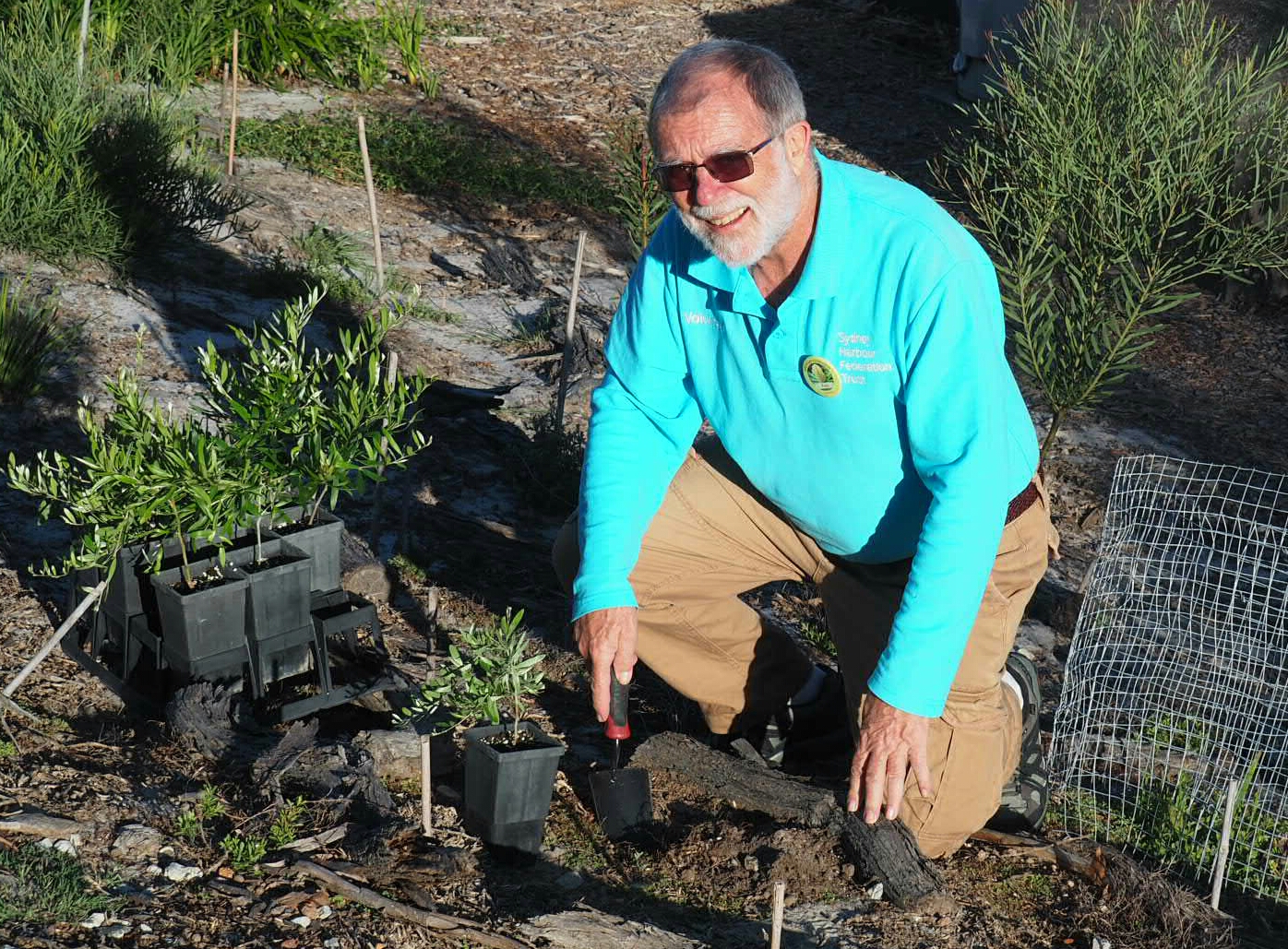
''There's more to bush regen than planting, but weeding reflects cruelty to plants :-) '' - Peter Macinnis
There have been 378 echidnas rescued across this LGA in the collected data between June 2013 and June 30 2021, and just 109 re-released. Collision with motor vehicles is listed as the primary cause for rescues - echidnas will cross roads to move between urban habitats, with an increasing likelihood of road fatalities during the breeding season for this species. Breeding season begins in late June and extends through September. Males will form lines up to ten individuals long, the youngest echidna trailing last, that follow the female and attempt to mate. During a mating season an echidna may switch between lines. This is known as the "train" system.
Echidnas, sometimes known as spiny anteaters, are quill-covered monotremes (egg-laying mammals) belonging to the family Tachyglossidae. The four extant species of echidnas and the platypus are the only living mammals that lay eggs and the only surviving members of the order Monotremata. The diet of some species consists of ants and termites. Echidnas evolved between 20 and 50 million years ago, descending from a platypus-like monotreme. This ancestor was aquatic, but echidnas adapted to life on land.
Echidnas are very timid animals. When they feel endangered they attempt to bury themselves or if exposed they will curl into a ball similar to that of a hedgehog, both methods using their spines to shield them. Strong front arms allow echidnas to continue to dig themselves in whilst holding fast against a predator attempting to remove them from the hole.
Although they have a way to protect themselves, the echidnas still face many dangers. Predators include feral cats, foxes, domestic dogs, and goannas. Snakes pose a large threat to the echidna species because they slither into their burrows and prey on the young spineless puggles.
Some precautions that can be taken include keeping the environment clean by picking up litter and causing less pollution, planting vegetation for echidnas to use as shelter, supervising pets, reporting hurt echidnas, and leaving them undisturbed. Merely grabbing them may cause stress, while picking them up improperly may result in injury.
_____________________________________________________________________________________
Peter Carter
Avalon Beach SLSC Boat Captain, third generation Careel Bay gentleman – Peter’s family have been in our area for over 100 years.
What is your favourite local wildlife species?
The ringtail possum. We used to have little ringtails come around the house all the time. We had a blind mother that would bring her babies and we’d feed them.
The main diet of the Ringtail Possum is eucalyptus leaves although they will eat other foods such as fruits, flowers and leaves of other native trees. They are also known to eat rose buds in suburban areas, so we were well set to help out when she needed it, especially when she had new babies.
It was great growing up around here and feeding the local ringtails.
Why do you like the ringtail possum?
They’re just cute little things and they are so loving towards us humans and their babies. When you get to know them you realise this is a family, like any other family. When they’re eating they have their little paws up like this and look like little humans eating with their hands.
How long have seen or heard the ringtail possum?
Oh, the Carters have been around this area for a few generations and we’d always see lots of wildlife here.
Have you noticed any changes in the number of ringtail possums in your local neighbourhood?
Yes, we haven’t seen any little ringtails for a long time. Obviously people letting domestic animals near them seems to be a problem, people letting their cats out at night.
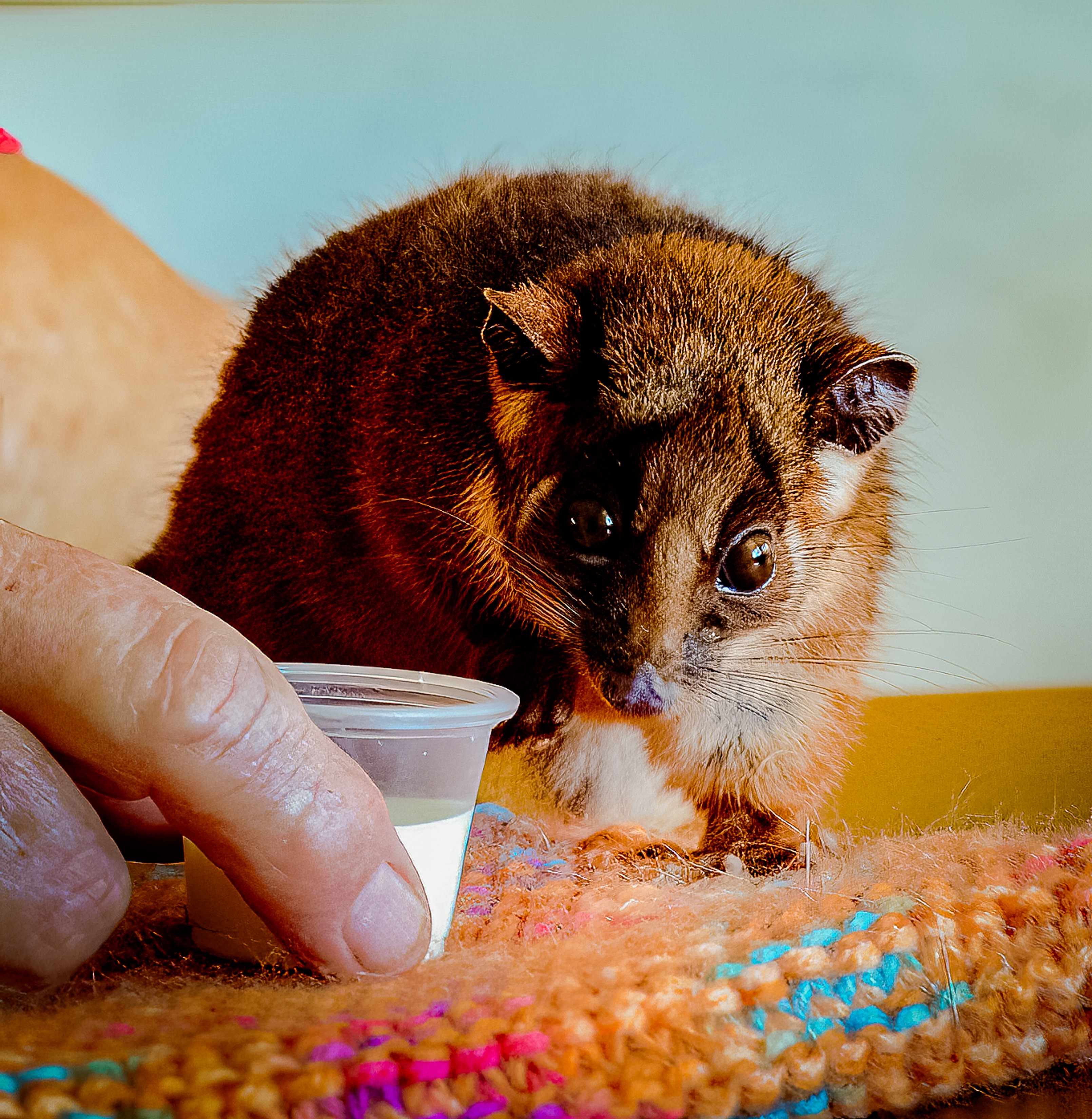
Baby Ringtail in care. Photo: Michael Mannington OAM
Peter Carter. Photo: A J Guesdon
The data collected by the NSW Department of the Environment states 50, 500 Ringtail possums have been rescued across NSW during the June 2013 to June 2021 period, the bulk of this in and around Sydney, and 12, 724 released.
In this LGA a total of 7, 118 have been rescued and 1, 978 released.
'Fallen from nest or tree' is listed as the primary cause of rescues in this area, especially during the 2017-18 and 2020 to 2021 years. Cat attacks is listed as the second primary cause of rescues and fatalities.
In 2020 to 2021 994 were rescued in this LGA and 348 released - 646 died as a result of their injuries or being thrown from their homes. Clearing habitat – the trees and underbrush they live and nest in, is what is killing these other residents - with 'abandoned/orphaned' and 'fallen from tree or nest' again listed as the primary causes during 2020-21, followed by attacks by domestic cats.
Because they are largely arboreal, common ringtail possums are particularly impacted by deforestation in Australia at an urban and rural scale. They are also heavily predated upon by the introduced red fox. They are also hit by cars, or killed by snakes, and cats and dogs in suburban areas.
Ringtail possums (Pseudocheirus peregrinus), referred to as 'common ringtail possums' despite them not being so common anymore, weighs between 550 and 1,100 g (19 and 39 oz) and is approximately 30–35 cm (12–14 in) cm long when grown (excluding the tail, which is roughly the same length again). It has grey or black fur with white patches behind the eyes and usually a cream-coloured belly. It has a long prehensile tail which normally displays a distinctive white tip over 25% of its length. The back feet are syndactyl, which helps it to climb. The ringtail possum's molars have sharp and pointed cusps.
Common ringtail possums live a gregarious lifestyle which centres on their communal nests, also called dreys. Ringtail possums build nests from tree branches and occasionally use tree hollows. A communal nest is made up of an adult female and an adult male, their dependant offspring and immature offspring of the previous year. A group of ringtail possums may build several dreys at different sites. Ringtail possums are territorial and will drive away any strange conspecifics from their nests. A group has a strong attachment to their site. In one experiment, in which a group was removed from their territory, it remained uncolonised for the following two years. Ringtail possum nests tend to be more common in low scrub and less common in heavily timbered areas with little under-story. Dreys contribute to the survival of the young when they are no longer carried on their mother's back.
The ringtail possum carries its young in a pouch, where it develops. Depending on the area, the mating season can take place anywhere between April and December. The majority of the young are born between May and July. The oestrous cycle of ringtail possum lasts 28 days. It is both polyoestrous and polyovular. If a female prematurely loses her litter, she can return to oestrous and produce a second litter in October as a replacement if conditions are right. The average litter is two, although there are very occasionally triplets. Common ringtail possum young tend to grow relatively slowly due to dilute milk with low lipid levels that is provided to the young. As with other marsupials, the common ringtail possum's milk changes through lactation. During the second phase of lactation, more solid foods are eaten, especially when the young first emerges from the pouch. During this time, the concentration of carbohydrates fall, while those of proteins and lipids reach their highest. The long lactation of the ringtail possums may give the young more time to learn skills in the communal nest as well as to climb and forage in the trees. The young are first able to vocalise and open their eyes between 90 and 106 days of age. They leave their mother's pouch at 120–130 days. However, lactation usually continues until 180–220 days after birth but sometimes ends by 145 days.
_____________________________________________________________________________________
Nathan Wellings
Avalon Beach SLSC Boat Captain, grew up in our area.
What is your favourite local wildlife species?
That would be the kookaburra.
Why do you like the kookaburra?
They come out to our backyard and sit on the clothesline and swoop down on the bugs when I’m gardening. When you’re out there shovelling dirt they’re always there looking for food. We did a big dig in the backyard last April and there was always 3 or 4 hanging around.
They’re such a nuggety solid animal, I love their colours – and they move around as a family unit, which is what we are too. Their territorial song of a morning and at f=dusk is good to – a great sound.
How long have seen or heard this animal?
I’ve seen them around here for the whole time I’ve been here.
Have you noticed any changes in the number of these animals in your local neighbourhood?
We only get ones that fly in for a feed and then out again. I haven’t seen any babies or fledglings, but I’m aware that some do have nests in the trees in our neighbourhood at North Avalon. They don’t nest around our yard, possibly because we have a couple of dogs in the yard, but I do see them moving around our streets in a group. I like them, they’re great.
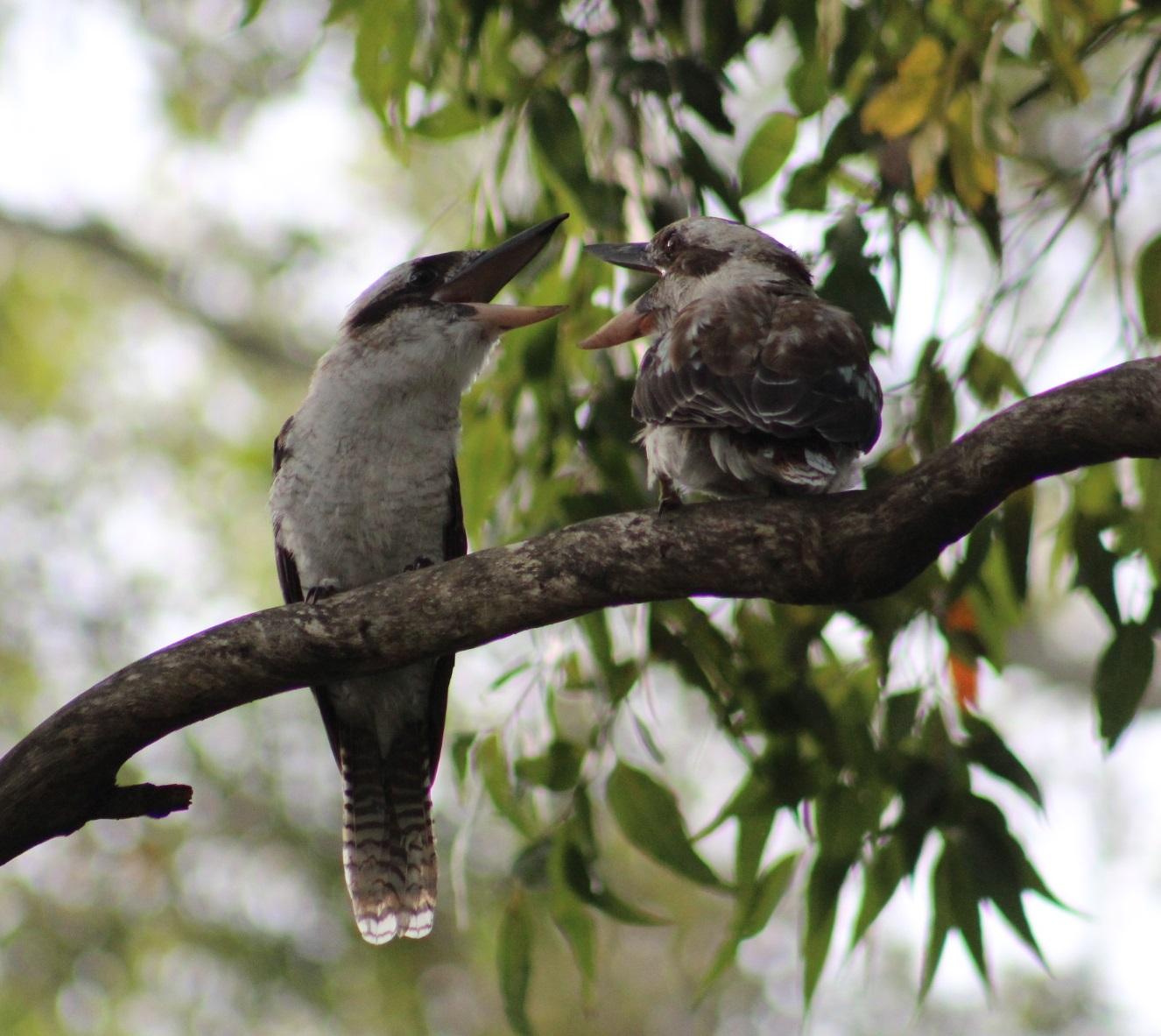
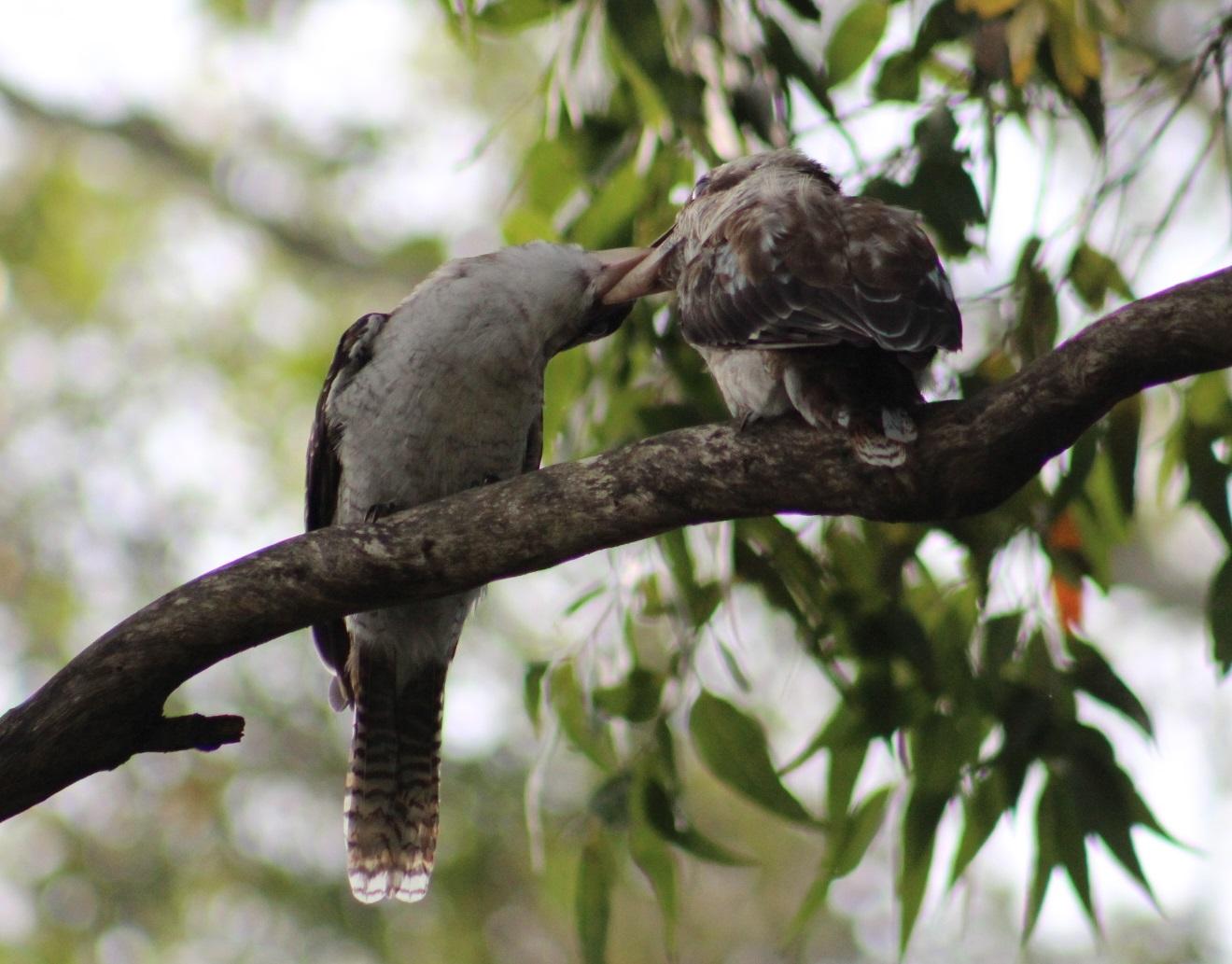
There have been 22, 300 Laughing Kookaburras rescued across NSW during the June 2013 to June 2021 data period, with 8, 176 released. Collisions with motor vehicles is listed as the primary cause of rescues elsewhere.
For this LGA that data states 1, 449 have been rescued and 580 released with 1, 141 listed as needing rescuing due to an 'unknown cause'. The local rescues have escalated over recent years with 198 listed for 2020-21 alone. Further information states of the known causes for rescue 73 of these had dependent young, 24 had been attacked, 20 were rescued due to being in an 'unsuitable environment', 18 due to entanglement and 13 due to human impact - 2 had been poisoned.
The laughing kookaburra (Dacelo novaeguineae) is a bird in the kingfisher subfamily Halcyoninae. It is a large robust kingfisher with a whitish head and a brown eye-stripe. The upperparts are mostly dark brown but there is a mottled light-blue patch on the wing coverts. The underparts are cream-white and the tail is barred with rufous and black. The plumage of the male and female birds is similar. The territorial call is a distinctive laugh that is often delivered by several birds at the same time.
Their usual habitat is open sclerophyll forest and woodland. It is more common where the understory is open and sparse or where the ground is covered with grass. Tree-holes are needed for nesting. It also occurs near wetlands and in partly cleared areas or farmland with trees along roads and fences. In urban areas it is found in parks and gardens.
Nest-building may start in August with a peak of egg-laying from September to November. If the first clutch fails, they will continue breeding into the Summer months.
The female generally lays a clutch of three semi-glossy, white, rounded eggs, at about two-day intervals. Both parents and auxiliaries incubate the eggs for 24–26 days. Hatchlings are altricial and nidicolous, fledging by day 32–40. If the food supply is not adequate, the third egg will be smaller and the third chick will also be smaller and at a disadvantage relative to its larger siblings.
Common prey include mice, which makes them susceptible to rate poisons, and similar-sized small mammals, a large variety of invertebrates (such as insects, earthworms and snails), yabbies, small fish, lizards, frogs, small birds and nestlings, and most famously, snakes. When feeding their young, adult laughing kookaburras will make “Chuck calls”, which are deep, guttural calls that differ significantly from their daily chorus songs.
Kookaburras tend to live in family units, with offspring helping the parents hunt and care for the next generation of offspring.
Careel Bay kookaburra fledglings being fed a snake. Photo: A J Guesdon
Rat poison is killing our beloved native owls and tawny frogmouths – and that’s the tip of the iceberg
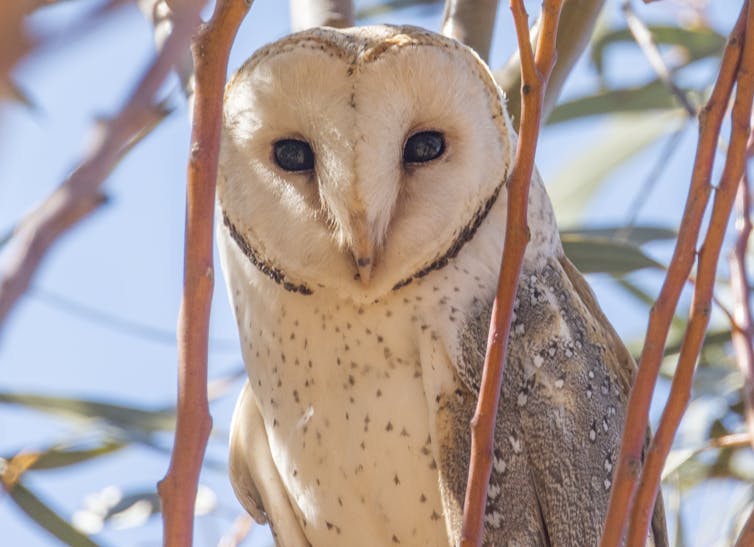
There’s nothing quite like having a rodent problem in your home. Most people will do anything to get rid of them.
Australians usually reach for rat poison, without a second thought. Most of these poisons – sold at supermarkets and hardware stores – are “second-generation anticoagulant rodenticides” (SGARs) also known as single-dose anticoagulants. These extremely powerful poisons stay in the body for many months. It takes only a single feed to kill a rodent, usually within a week.
With the rodent problem solved, our house is once again our castle, and all is well. Right?
Unfortunately, use of rat poison is leading to the wide-scale poisoning of Australia’s nocturnal predatory birds, including the crowd favourite tawny frogmouth and Australia’s largest owl, the majestic powerful owl. Our new research reveals the alarming extent of the problem.
Poisoning In Tawny Frogmouths And Owls
Anticoagulant rat poisons are effective at killing rodents, but they also accumulate in the liver and muscle tissues of predators that eat the poisoned animals.
The SGARs do not kill immediately, it can take many days. During that time, the rodent – or any other animal that eats the poison – can keep eating more. The poison does not leave the body but continues to accumulate in tissues while attacking the body’s capacity to clot blood. Eventually the poisoned animal dies from internal bleeding.
While still alive, the poisoned animal makes easy prey because it becomes lethargic and doesn’t behave in a normal, cautious manner.
Eating a single poisoned rodent probably won’t kill a predator, but what happens when predators are exposed to poisoned prey all the time? This is probably what is happening in our cities, suburbs and farms, every day of the year.
Here’s What We Found
Our new research reveals alarming levels of rat poisons in our nocturnal predatory birds. Across four species, we found a staggering 92% of the 60 dead birds we tested had been exposed to these poisons. The concentration of SGARs in the liver was such that toxic or lethal impacts were likely to have occurred in 33% of powerful owls we tested, 68% of tawny frogmouths, 42% of southern boobooks and 80% of barn owls.
Testing for rat poison is not a pretty job. The only accurate way is to test the animal’s liver. Over the last two years, our team had the gruesome job of collecting and dissecting the livers of 60 dead owls and tawny frogmouths (24 powerful owls, 19 tawny frogmouths, 12 southern boobooks, and five eastern barn owls). Most birds were from Victoria. We were aided by concerned citizens who found and reported these dead birds to us, often collecting the bodies themselves and keeping them in their fridges.
Of the 55 birds found to have rodenticides in them, every one contained brodifacoum. Brodifacoum is the most widely available SGAR in Australia. It is highly potent and can stay in the body for more than 100 days. That means animals can accumulate more in their bodies as they continue to eat poisoned prey.
Are We Also Poisoning Other Native Animals?
Our research shows poisoning rodents is poisoning our predators, in large numbers. This is widespread across urban areas, agricultural areas and forests on the edge of suburbia.
Given the high rate of exposure to rat poisons, it is likely predator populations will decline. Losing our predators to poisoning will have widespread consequences, for natural systems and urban environments. Birds of prey help to keep rodents (and other species prone to reaching high numbers) in check.
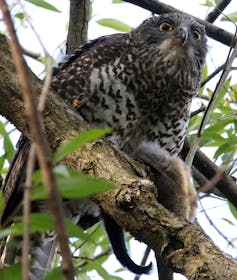
We are probably inadvertently poisoning other native animals. Powerful owls do not eat many rats, they prefer to dine on native possums and gliders. The common brushtail possum, with its broad diet and penchant for living in roof cavities, is no doubt directly feasting on rat poison.
So the high level of rat poison we found in nocturnal predators is likely the tip of a poisoned iceberg.
Is This A New ‘Silent Spring’ Moment?
In 1962, biologist Rachel Carson’s book Silent Spring introduced the world to the impacts of pesticides on humans and non-target species. This catalysed investigations into pesticides such as DDT, which were being passed up the foodchain and “bio-accumulating” in raptors, decimating populations. Now, the devastating impacts of SGARs are becoming more widely recognised.
Our research, along with a growing body of international evidence, highlights the need to introduce restrictions on the availability of SGARs in Australia.
As with DDT in the 1980s, many countries such as the United States, Canada and the United Kingdom are moving to ban public access to SGARs or substantially restrict how they can be used.
But Australia is lagging on the effective regulation on the use of SGARs. Currently, SGARs are approved for use “in and around domestic, commercial, industrial and agricultural buildings”. They are not approved for use in crops, in the open, or in other areas accessible to non-target animals or children. But these restrictions are not sufficient. It is also likely many people do not follow instructions when they use rat poisons.
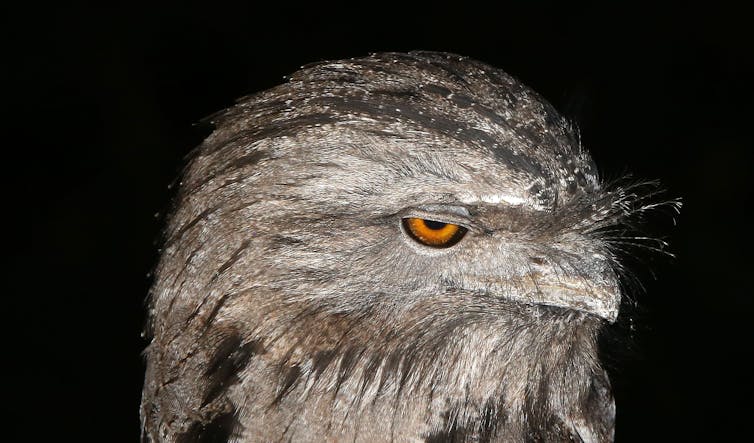
What Are The Alternatives To Rat Poison?
Next time you reach for the rat poison, consider the consequences. There is a very strong likelihood you will poison more than rodents – you could be poisoning a tawny frogmouth or owl.
Try to approach the problem without using poisons. In particular, avoid any SGAR-based products (those containing brodifacoum, bromadiolone, difenacoum, difethialone and flucoumafen as the active ingredients).
There are ways to control rats and mice without harming native wildlife. Trapping technology has come a long way and the latest methods are far more effective, humane and efficient than the old-fashioned spring-loaded mouse trap.
We can also make our homes less attractive to vermin, by clearing vegetation close to the house, reducing the availability of food sources such as pet food and compost, and blocking access to the building. And of course, we can support our natural predators to do what they do best, without putting themselves in harm’s way.![]()
John White, Associate Professor in Wildlife and Conservation Biology, Deakin University and Raylene Cooke, Associate Professor, Deakin University
This article is republished from The Conversation under a Creative Commons license. Read the original article.
Hard To Spot, But Worth Looking Out For: 8 Surprising Tawny Frogmouth Facts
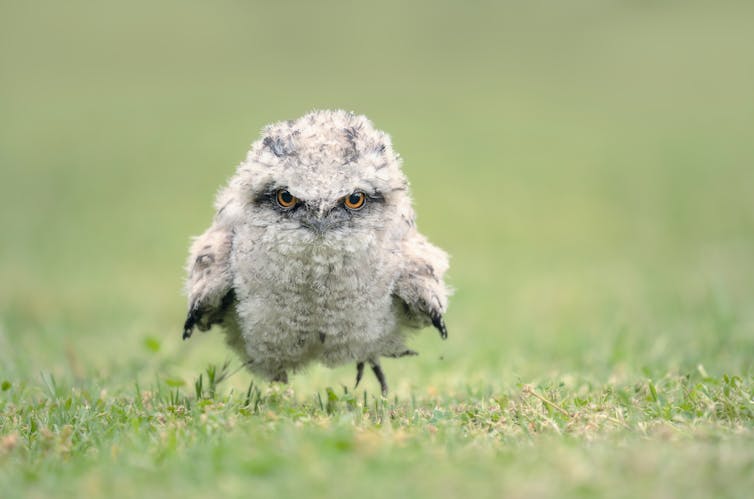
The tawny frogmouth is one of Australia’s most-loved birds. In fact, it was first runner-up in the Guardian/BirdLife Australia bird of the year poll (behind the endangered black-throated finch).
Tawny frogmouths are found throughout Australia, including cities and towns, and population numbers are healthy. We’re now in the breeding season – which runs from August to December – so you may have been lucky enough to see some pairs with chicks recently.
Here are eight fascinating things about tawny frogmouths that you might not know.

Read more: What Australian birds can teach us about choosing a partner and making it last
1. They Are Excellent Parents
Tawny frogmouths are excellent parents. Both males and females share in building the nest and incubating the eggs, generally one to three. The eggs take 30 days to hatch, with the male incubating during the day and both sexes taking turns during the night.
Once hatched, both parents are very involved in feeding the fledglings. A young bird’s wings take about 25 to 35 days to develop enough strength for flight (a process known as “fledging”).
2. They Mate For Life
Tawny frogmouths pair for life. Breeding pairs spend a great deal of time roosting together and the male often gently strokes the female with his beak. Some researchers report seeing tawny frogmouths appear to “grieve” when their partner dies.
For example, renowned bird behaviour expert Gisela Kaplan tells of rearing a male tawny frogmouth on her property then releasing it to the wild. It found a female mate and raised nestlings. One day, the female was run over on the highway; Kaplan recognised its markings.
She found the male “whimpering” on a nearby post. Kaplan reportedly said: “It sounds like a baby crying. It affects you to listen to it.” According to Kaplan, the male stayed there for four days and nights, and did not eat or drink.
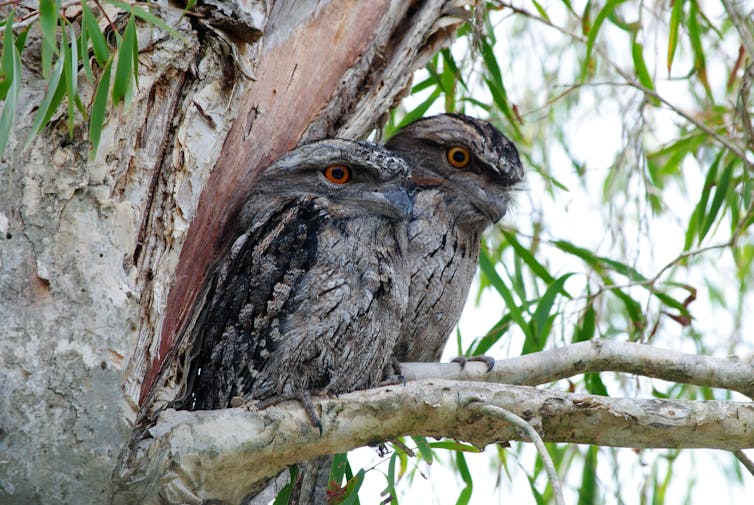
3. They’re Not Owls
Although tawny frogmouths are often referred to as owls, they are not. But they do resemble owls with their large eyes, soft plumage and camouflage patterns, because both owls and frogmouths hunt at night. This phenomenon (where two species develop the same attributes, despite not being closely related) is called “convergent evolution”.
Unlike owls, tawny frogmouths do not have powerful feet and talons with which to capture prey. Instead, they prefer to catch prey with their beaks. Their soft, wide, forward-facing beaks are designed for catching insects. They will also feed on small birds, mammals and reptiles.
4. They Are Masters Of Disguise
Tawny frogmouths are extremely well camouflaged and when staying statue-still on a tree branch they appear to be part of the tree itself. They often choose to perch near a broken tree branch and thrust their head at angle, further mimicking a tree branch.
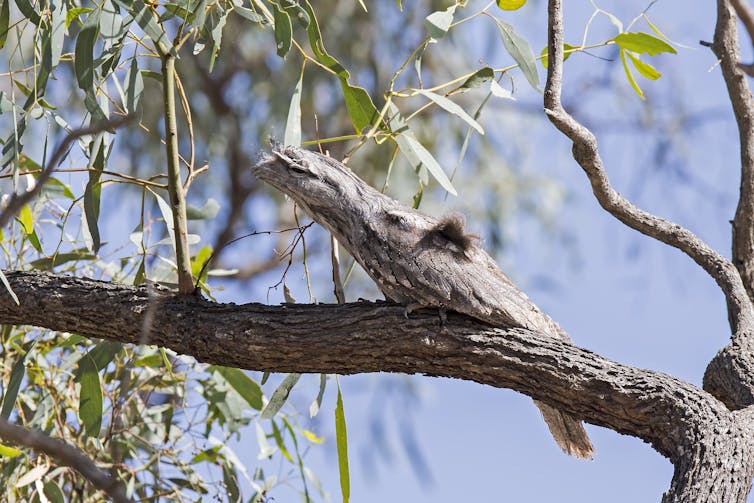
5. They Make Strange Noises
Tawny frogmouths are quite vocal at night and have a range of calls from deep grunting to soft “wooing”. When threatened, they make a loud hissing sound. Their vocalisations have also variously been described as purring, screaming and crying.
6. They Can Survive Extremes
In colder regions of Australia, tawny frogmouths are able to survive the winter months by going into torpor for a few hours. In this state, an animal slows its heart rate and metabolism and lowers its body temperature to conserve energy.
On very hot summer days tawny frogmouths will produce mucus in their mouths which cools the air they breathe in, thereby cooling their whole body.
7. They Need Old Trees
It’s not that uncommon to see tawny frogmouths dead on the road; they often flit across the road chasing insects at night and can be hit by cars.
Tawny frogmouth populations are holding relatively steady, but there is a shortage of old trees for nesting. They especially like trees with old branches as they mimic old branches and stick out like sore thumbs on young branches.
When one NSW council chopped down a suburban tree that a tawny frogmouth pair had reportedly used for years as a nesting site, one of the birds was photographed sitting on a nearby woodchipper — a poignant image.
8. They’re Not Good At Building Nests.
Tawny frogmouths are pretty slack when it comes to nest building. They simply dump twigs and leaves in a pile and that is it. Chicks and eggs have even fallen out of the nest when parents are swapping brooding duties.
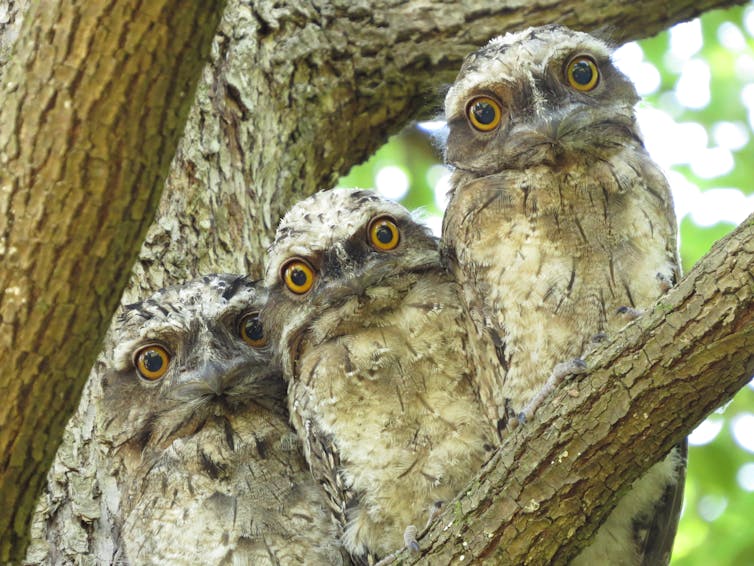
Read more: Laughs, cries and deception: birds' emotional lives are just as complicated as ours ![]()
Les Christidis, Professor, Southern Cross University
This article is republished from The Conversation under a Creative Commons license. Read the original article.
Curious Kids: if trees are cut down in the city, where will possums live?
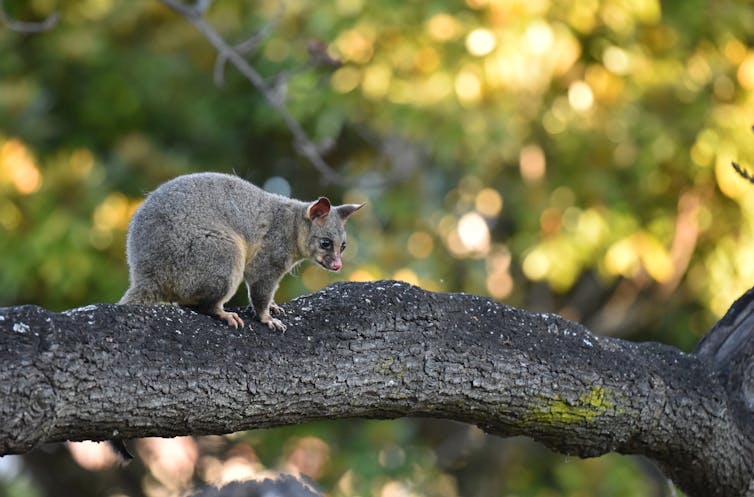
If trees are cut down in the city, where will possums live? - Millie, age 9, Sydney.
Hi Millie.
Thanks for your question. I worry about this too.
Trees are really important to possums in the city. Like lots of Australian animals, possums depend on hollows — a hole that forms in trees as they get older. Because possums are nocturnal (meaning they only come out at night), they need somewhere safe to curl up and sleep during the day. A nice cosy tree hollow is the perfect place.
Tree hollows are special because they take a long time to make. They usually happen when a tree gets injured and the place where it broke starts to rot away, eventually forming a hole. Most types of gum tree don’t even start making hollows until they’re more than 100 years old. Usually, the bigger the tree, the more hollows you’re likely to find.
Out in the bush, a possum might have lots of different trees and hollows to choose from. Some kinds of possum might have 12 different hollows – 12 bedrooms! Can you imagine?
But in the city, we don’t have as many big trees with hollows, so possums can’t be as picky about their bedrooms. And when a big old tree dies or is cut down, even if we plant a new one we might have to wait hundreds of years before it provides a good possum house. This means the possums have to look for somewhere else to live.
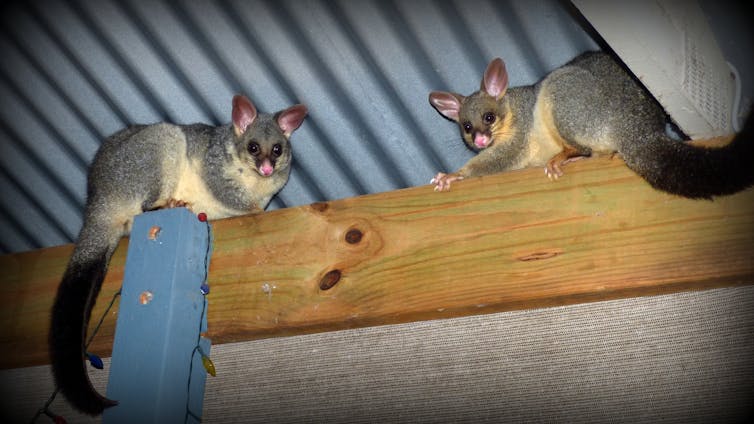
Other Possum Places In The City
Now, there are a few other places that possums might find in the city.
They want somewhere dark, dry and warm, and they don’t mind if they’re not supposed to be there.
That’s why people often find possums sleeping in their roof, in old pots in the garden, or even inside a barbecue!
Tiny possums can squeeze into even smaller places. Sugar gliders are sometimes found in electricity boxes, and feathertail gliders might nest in a drainpipe.
It’s amazing how resourceful animals can be! But these aren’t very safe places for possums to make a home. So there are two things we can do to help.
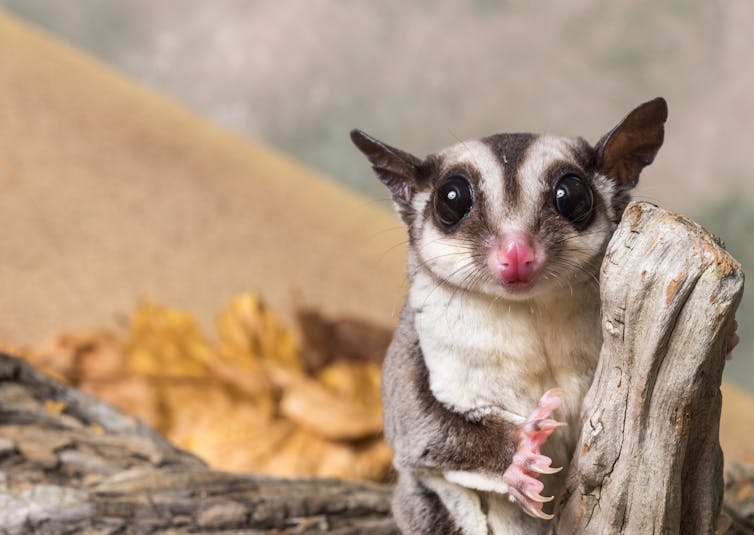
1. Protect Our City’s Big Trees
There aren’t many left, so every single tree is important. And it’s not just gum trees — lots of types of trees make hollows or provide food for native animals. Even dead trees!
Great big trees can get dangerous as they get older because if they drop branches or fall over they could hurt someone. Sometimes tree experts can use cables to keep the trees upright and safe, or only cut down the dangerous branches.
Or sometimes we can fence the area so that people don’t walk underneath. If a tree does have to be cut down, scientists came up with an idea to move the whole tree to a new spot — like a tree transplant! The tree can’t grow anymore, but it still has all the hollows possums and other animals need to make their homes.
2. Build New Possum Homes
There are lots of different ways to build new hollows for wildlife. Nest boxes (sometimes known as dreys) might be made out of wood, or old hollow logs, or even pot plant liners.
Sometimes local councils will use a chainsaw to carve holes into trees to make new homes for wildlife.
And other scientists are using 3D printers to make hollows that mimic the same shapes as real hollows (but we need to make sure the designs are safe).
City trees are so important. They help keep us cool in summer, make the air nice and fresh, and they’re nice to look at. Some of them have been here longer than the buildings.
So protecting trees in the city isn’t just good for possums. It’s good for humans, too.
Hello, Curious Kids! Have you got a question you’d like an expert to answer? Ask an adult to send your question to curiouskids@theconversation.edu.au![]()
Kylie Soanes, Postdoctoral Fellow, School of Ecosystem and Forest Sciences, The University of Melbourne
This article is republished from The Conversation under a Creative Commons license. Read the original article.
Wallaby On Station Beach - Lives In Dunes At North Palm Beach
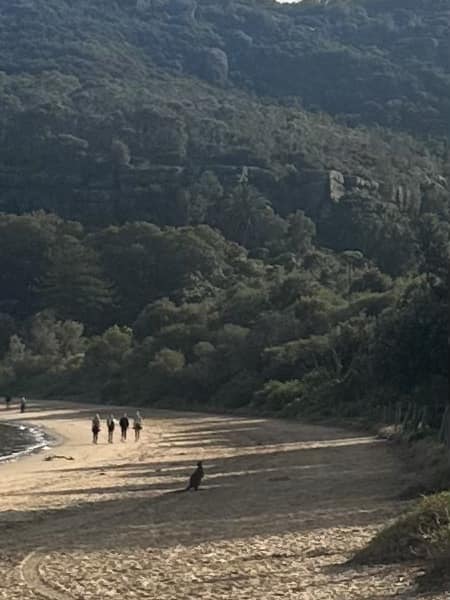
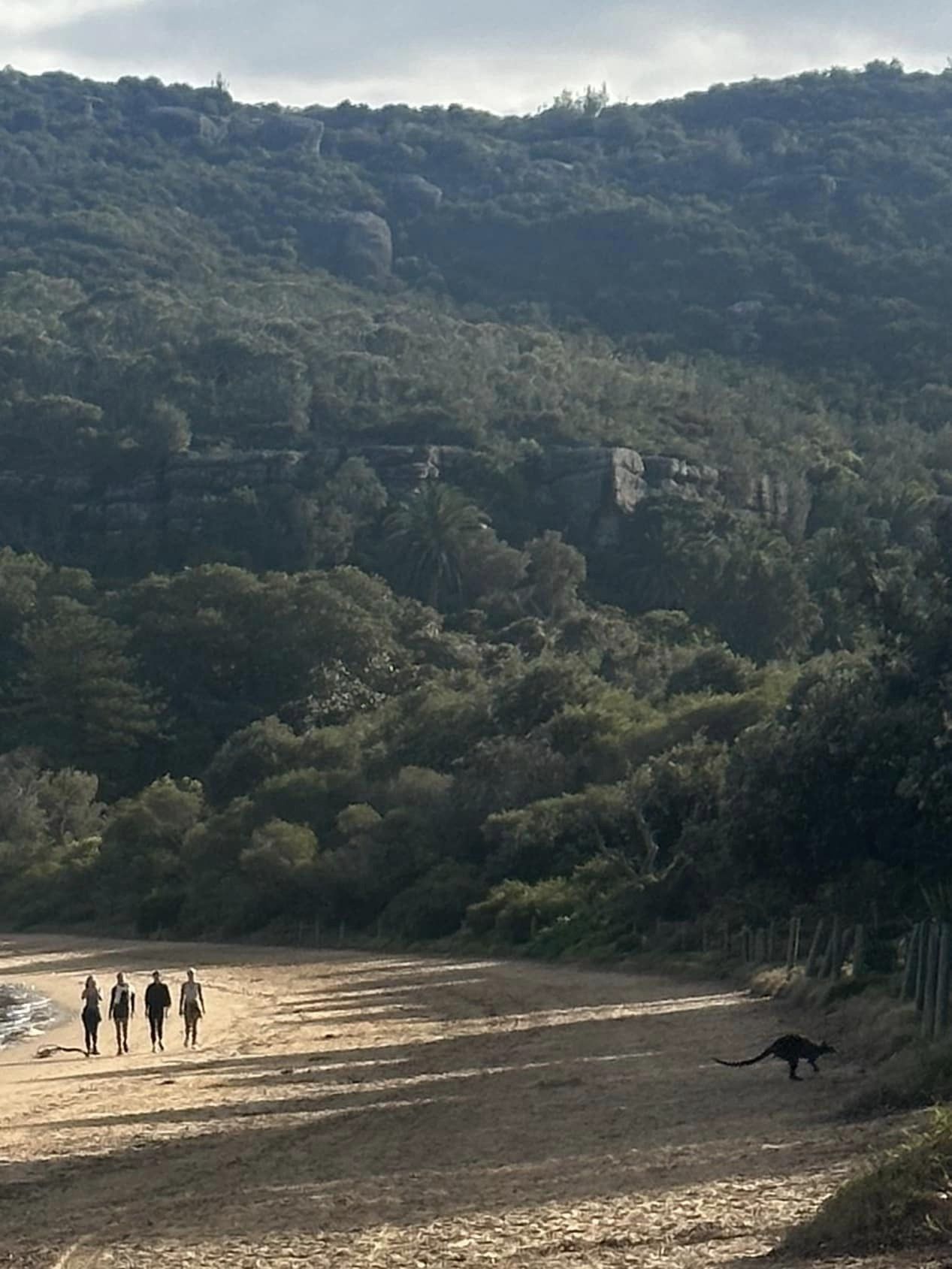
With hundreds of call-outs every day, wildlife rescue services can help us understand the threats to our native animals
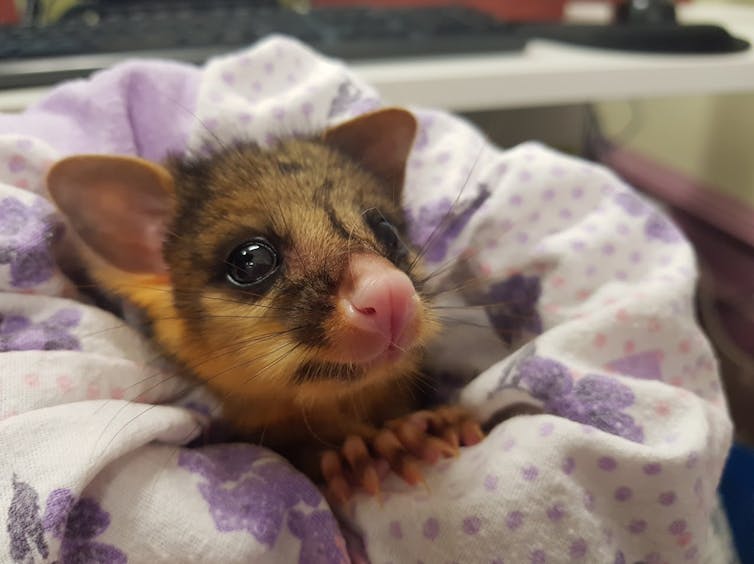
Imagine coming across an injured kangaroo on the side of the road. Or a bat entangled in fruit tree netting. Would you know who to call to get help?
After a quick search, you find the number of your local wildlife rescue service and give them a call. A trained operator gathers the information they need to assess your case and coordinate rescue and rehabilitation if needed.
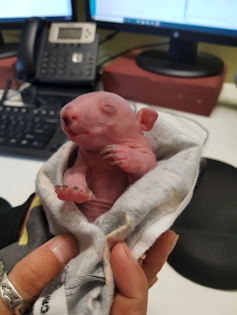
Across Australia, wildlife emergency response hotlines, such as Wildlife Victoria in Victoria, WIRES in New South Wales and smaller groups throughout the country, offer valuable help to wildlife and members of the public who encounter wildlife emergencies. Data from these services can also help us understand how human activities harm wildlife at a local level. And that in turn highlights what can be done to better protect wildlife.
In newly published research, our team analysed a ten-year dataset from Wildlife Victoria, the main wildlife emergency response service in that state. The service responded to more than 30,000 cases a year, on average, between 2010 and 2019. Around 400 cases a year involved threatened species.
Human Activities Are The Greatest Threat
Many such services operate on a daily basis. They collect enormous amounts of information on human and non-human threats to wildlife, particularly in urban areas.
When you call a service about an animal, a rescuer might need to attend or, if safe to do so, you might be asked to take the animal to a vet clinic free of charge for assessment. Or it might be that the animal, such as a fledgling bird on the ground, just needs to be left alone.
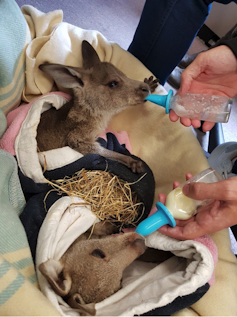
Confirming what studies in Australia and elsewhere have shown, our results demonstrate that human activities do the most harm to wildlife, as opposed to more natural causes such as severe weather or being preyed on by other animals. A majority of cases were reported in the Greater Melbourne area rather than the rest of the state.
As might be expected, common species accounted for most cases. Eastern grey kangaroos, ringtail and brushtail possums and magpies were the most commonly reported species.
Of 443 identified species reported to the service, 81 were listed as threatened. The majority of cases involving threatened species (on the Fauna and Flaura Guarantee Act 1988 Threatened List) concerned grey-headed flying foxes.
Generally, the main causes for concern were collisions with vehicles, animals found in an abnormal location (an unnatural habitat where they did not belong) or in buildings, and attacks by cats or dogs.
Some species were disproportionately impacted by some threats rather than others and in some locations. For example, kangaroos and koalas were more likely to be victims of vehicle collisions outside Greater Melbourne. In contrast, ringtail possums were more likely to be attacked by cats within the metropolitan area.
Flying foxes were more frequently reported within Greater Melbourne. The main cause of concern was entanglements in nets such as fruit tree netting. The data thus confirmed the danger these nets present.

Services Struggle To Keep Up With Demand
Worryingly, Wildlife Victoria recorded a 2.5-fold increase in reported cases from 2010 to 2019.
However, such services are often under-resourced. While the number of cases increased, the number of volunteers able to respond to cases did not. This means a lower proportion of all cases can receive the support they need.
Using data from services such as Wildlife Victoria can help us understand service-demand gaps and where resources would be best allocated to fill these gaps.
We also showed such services provide invaluable education to the community. Around one in five calls resulted in education, rather than requiring an emergency response.
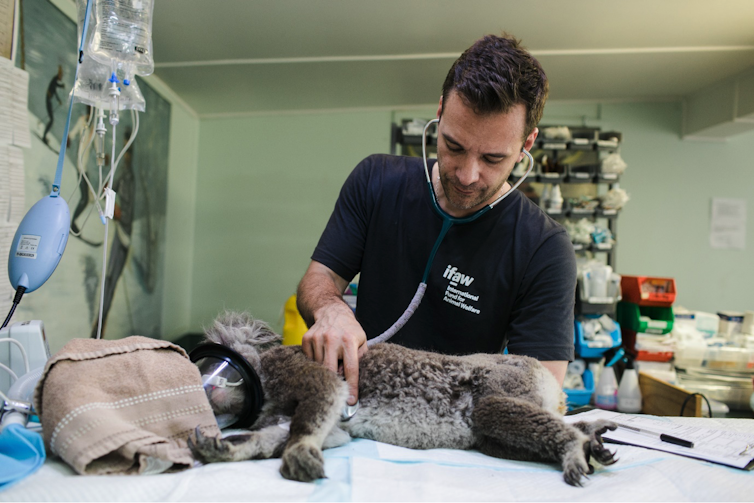
Databases Are A Largely Untapped Resource
Wildlife emergency response services have a wealth of data that describe the species-specific and location-specific threats wildlife face. Local wildlife managers and organisations interested in protecting wildlife from common threats before they occur could use this data to understand what they can do to achieve this.
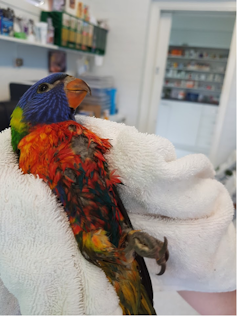
For example, the data can help pinpoint where measures such as educating the community on responsible pet ownership, banning the sale of dangerous netting or wire and reducing speed limits would be effective depending on the wildlife affected in specific areas.
The data could also help monitor the success of new laws, campaigns and measures to protect wildlife. For example, researchers in Queensland have used data from their local wildlife rescue services to quantify the reduction in koala deaths from car strikes and dog attacks following a campaign to raise awareness of threats to koalas. This source of information is invaluable because such data can be hard and costly for ecologists and conversationists to collect.
Interested in interacting with Wildlife Victoria’s historical data? Check out this webpage. ![]()
Elodie Camprasse, Research fellow in spider crab ecology, Deakin University and Adam Cardilini, Lecturer, Environmental Science, School of Life and Environmental Science, Faculty of Science, Engineering and Built Environment, Deakin University
This article is republished from The Conversation under a Creative Commons license. Read the original article.
Leaving dog and cat poo lying around isn’t just gross. It’s a problem for native plants and animals, too
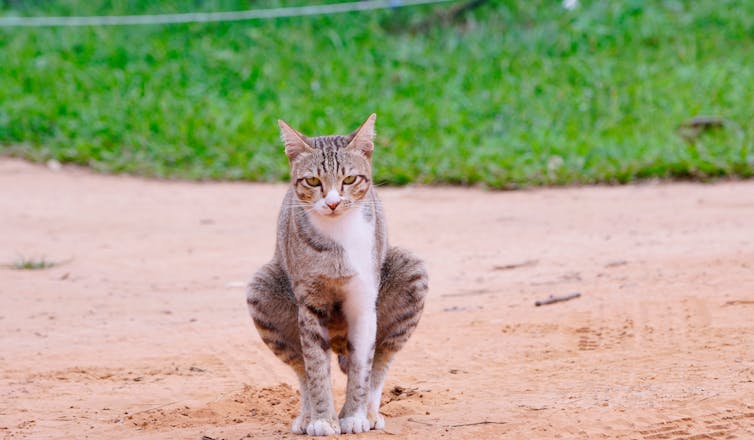
Dodging dog poo along the local path has become something of an Olympic sport of late. I thought I’d count path-side dog poo on my bike ride the other day and gave up after counting 30 piles in the first kilometre. It really does feel a bit out of control at the moment.
We know leaving dog poo lying around is bad for human health. But have you ever wondered what all this mess means for native wildlife?
It turns out pet poo – including both dog and cat poo – can have a number of negative effects on native plants and animals. And some of these might surprise you.
1. Unwelcome Fertiliser
Just like adding manure to the garden, pet poo left on the ground is a fertiliser. But not all plants thrive on excess.
Australian soils are naturally nutrient-poor and native plants and fungi are incredibly well-adapted to these conditions.
Yes, wildlife go to the toilet in nature too. But the difference is they also eat in nature – they’re part of the system.
Our pets, on the other hand, are fed nutrient-rich meals in our backyards and kitchens and then deliver these outside nutrients into the ecosystem. Pet poo can quickly find its way into waterways, which can drive algal blooms.
Researchers in Berlin estimated that if nobody picked up after their dogs, more than 11kg of nitrogen and 4kg of phosphorous per hectare would be added to urban nature reserves each year – levels that would be illegal for most farms.
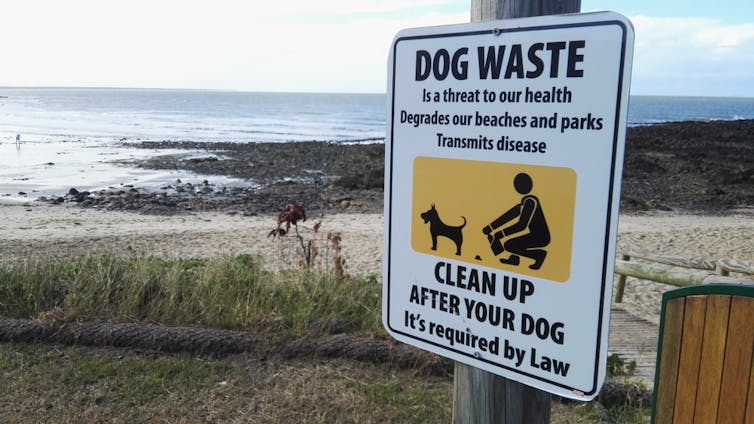
2. Lurking Disease
Pet cats aren’t off the hook. If you have a roaming kitty, they could be spreading toxoplasmosis – a disease that can cause serious illness and even death in native mammals.
Symptoms include blindness and seizures, and have been observed in kangaroos, wallabies, possums, wombats, bandicoots and bilbies. The disease even increases “risky” behaviours, with infected animals more prone to wandering around the open or being unafraid of predators.
It’s morbidly fascinating. The parasite causing the disease, Toxoplasma gondii, has two phases to its lifecycle. In the first phase, it’s happy hanging out inside pretty much any warm-blooded animal. But to complete the second phase, it has to jump to a cat. The easiest way to do this is to make your current host easy prey, hence the symptoms that debilitate native wildlife or make them prone to dangerous decisions.
Infected cats shed the parasite in their poo. So whenever native animals can come into contact with cat poo, they’re at risk. Researchers from the University of British Columbia found “wildlife living near dense urban areas were more likely to be infected”, citing domestic cats as the most likely culprit.
Worse, the parasite can lay dormant in poo for as long as 18 months, waiting for a host to jump into.
3. Eau De Predator
Finally, and probably the most obvious: dog poo might signal to wildlife that predators are about and they should stay away.
Even though dogs are a new predator to Australian wildlife, our native species have had enough experience existing alongside dingoes to consider your pooch a threat.
Recent research shows that in 83% of tests, Australian native mammals recognised dogs as a threat – with dog poo being a common trigger.
This means the signs and smells your dog leaves out and about can affect the behaviour of native wildlife.
For example, bandicoots in Sydney were less likely to visit backyards that had a resident dog, even if it was kept inside at night.
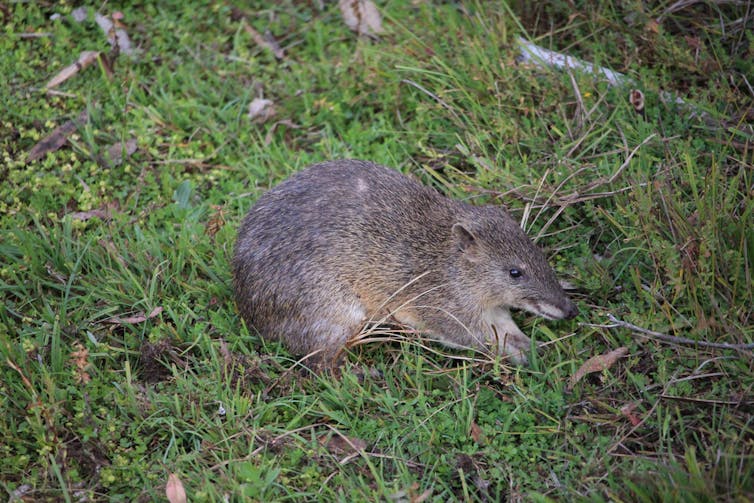
‘What Wildlife? What Nature? We Live In The City!’
It might surprise you to know we share our cities and towns with a huge range of native animals – even rare and endangered ones.
And as people have paid more attention to the nature in their local neighbourhood in recent years, we’re becoming more aware of the wildlife living right beneath our noses.
These species often depend on a seemingly rag-tag collection of urban green patches such as nature strips, utility easements, sports ovals and public gardens.
If these are all littered with smelly signs for wildlife to stay away, places safe for wildlife become even rarer in our cities. Reining in the pet poo problem is an easy way to reduce our impact.
The old adage “take only photographs, leave only footprints” is a good rule of thumb. Pick up after your pet and, importantly, take it with you to the nearest bin – don’t leave plastic bags dangling from fences like ornaments on the world’s worst Christmas tree. ![]()
Kylie Soanes, Postdoctoral Fellow, School of Ecosystem and Forest Sciences, The University of Melbourne
This article is republished from The Conversation under a Creative Commons license. Read the original article.